(pdf) Internet of things - IOT
VerifiedAdded on 2021/06/17
|17
|6434
|71
AI Summary
Contribute Materials
Your contribution can guide someone’s learning journey. Share your
documents today.
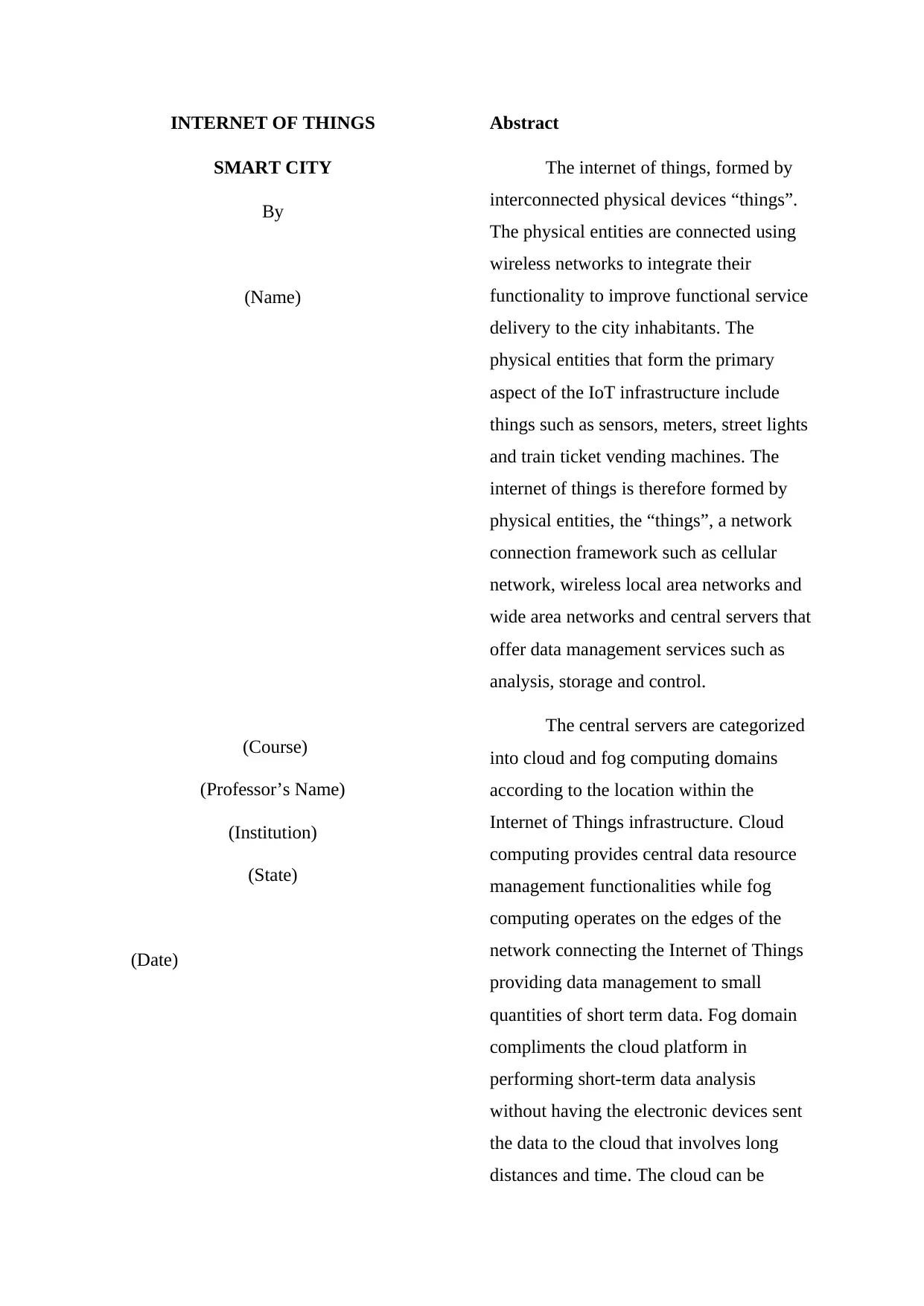
INTERNET OF THINGS
SMART CITY
By
(Name)
(Course)
(Professor’s Name)
(Institution)
(State)
(Date)
Abstract
The internet of things, formed by
interconnected physical devices “things”.
The physical entities are connected using
wireless networks to integrate their
functionality to improve functional service
delivery to the city inhabitants. The
physical entities that form the primary
aspect of the IoT infrastructure include
things such as sensors, meters, street lights
and train ticket vending machines. The
internet of things is therefore formed by
physical entities, the “things”, a network
connection framework such as cellular
network, wireless local area networks and
wide area networks and central servers that
offer data management services such as
analysis, storage and control.
The central servers are categorized
into cloud and fog computing domains
according to the location within the
Internet of Things infrastructure. Cloud
computing provides central data resource
management functionalities while fog
computing operates on the edges of the
network connecting the Internet of Things
providing data management to small
quantities of short term data. Fog domain
compliments the cloud platform in
performing short-term data analysis
without having the electronic devices sent
the data to the cloud that involves long
distances and time. The cloud can be
SMART CITY
By
(Name)
(Course)
(Professor’s Name)
(Institution)
(State)
(Date)
Abstract
The internet of things, formed by
interconnected physical devices “things”.
The physical entities are connected using
wireless networks to integrate their
functionality to improve functional service
delivery to the city inhabitants. The
physical entities that form the primary
aspect of the IoT infrastructure include
things such as sensors, meters, street lights
and train ticket vending machines. The
internet of things is therefore formed by
physical entities, the “things”, a network
connection framework such as cellular
network, wireless local area networks and
wide area networks and central servers that
offer data management services such as
analysis, storage and control.
The central servers are categorized
into cloud and fog computing domains
according to the location within the
Internet of Things infrastructure. Cloud
computing provides central data resource
management functionalities while fog
computing operates on the edges of the
network connecting the Internet of Things
providing data management to small
quantities of short term data. Fog domain
compliments the cloud platform in
performing short-term data analysis
without having the electronic devices sent
the data to the cloud that involves long
distances and time. The cloud can be
Secure Best Marks with AI Grader
Need help grading? Try our AI Grader for instant feedback on your assignments.
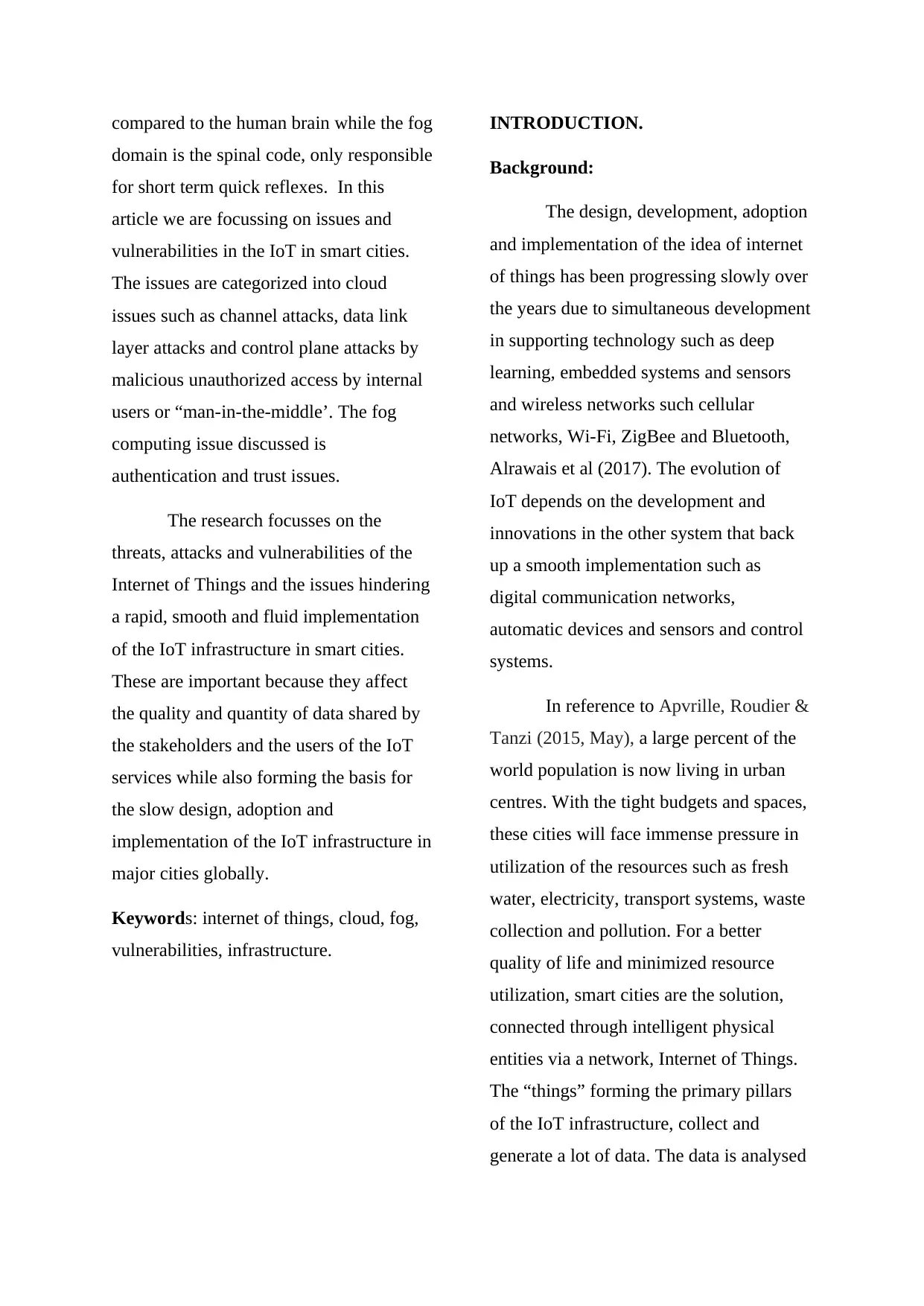
compared to the human brain while the fog
domain is the spinal code, only responsible
for short term quick reflexes. In this
article we are focussing on issues and
vulnerabilities in the IoT in smart cities.
The issues are categorized into cloud
issues such as channel attacks, data link
layer attacks and control plane attacks by
malicious unauthorized access by internal
users or “man-in-the-middle’. The fog
computing issue discussed is
authentication and trust issues.
The research focusses on the
threats, attacks and vulnerabilities of the
Internet of Things and the issues hindering
a rapid, smooth and fluid implementation
of the IoT infrastructure in smart cities.
These are important because they affect
the quality and quantity of data shared by
the stakeholders and the users of the IoT
services while also forming the basis for
the slow design, adoption and
implementation of the IoT infrastructure in
major cities globally.
Keywords: internet of things, cloud, fog,
vulnerabilities, infrastructure.
INTRODUCTION.
Background:
The design, development, adoption
and implementation of the idea of internet
of things has been progressing slowly over
the years due to simultaneous development
in supporting technology such as deep
learning, embedded systems and sensors
and wireless networks such cellular
networks, Wi-Fi, ZigBee and Bluetooth,
Alrawais et al (2017). The evolution of
IoT depends on the development and
innovations in the other system that back
up a smooth implementation such as
digital communication networks,
automatic devices and sensors and control
systems.
In reference to Apvrille, Roudier &
Tanzi (2015, May), a large percent of the
world population is now living in urban
centres. With the tight budgets and spaces,
these cities will face immense pressure in
utilization of the resources such as fresh
water, electricity, transport systems, waste
collection and pollution. For a better
quality of life and minimized resource
utilization, smart cities are the solution,
connected through intelligent physical
entities via a network, Internet of Things.
The “things” forming the primary pillars
of the IoT infrastructure, collect and
generate a lot of data. The data is analysed
domain is the spinal code, only responsible
for short term quick reflexes. In this
article we are focussing on issues and
vulnerabilities in the IoT in smart cities.
The issues are categorized into cloud
issues such as channel attacks, data link
layer attacks and control plane attacks by
malicious unauthorized access by internal
users or “man-in-the-middle’. The fog
computing issue discussed is
authentication and trust issues.
The research focusses on the
threats, attacks and vulnerabilities of the
Internet of Things and the issues hindering
a rapid, smooth and fluid implementation
of the IoT infrastructure in smart cities.
These are important because they affect
the quality and quantity of data shared by
the stakeholders and the users of the IoT
services while also forming the basis for
the slow design, adoption and
implementation of the IoT infrastructure in
major cities globally.
Keywords: internet of things, cloud, fog,
vulnerabilities, infrastructure.
INTRODUCTION.
Background:
The design, development, adoption
and implementation of the idea of internet
of things has been progressing slowly over
the years due to simultaneous development
in supporting technology such as deep
learning, embedded systems and sensors
and wireless networks such cellular
networks, Wi-Fi, ZigBee and Bluetooth,
Alrawais et al (2017). The evolution of
IoT depends on the development and
innovations in the other system that back
up a smooth implementation such as
digital communication networks,
automatic devices and sensors and control
systems.
In reference to Apvrille, Roudier &
Tanzi (2015, May), a large percent of the
world population is now living in urban
centres. With the tight budgets and spaces,
these cities will face immense pressure in
utilization of the resources such as fresh
water, electricity, transport systems, waste
collection and pollution. For a better
quality of life and minimized resource
utilization, smart cities are the solution,
connected through intelligent physical
entities via a network, Internet of Things.
The “things” forming the primary pillars
of the IoT infrastructure, collect and
generate a lot of data. The data is analysed
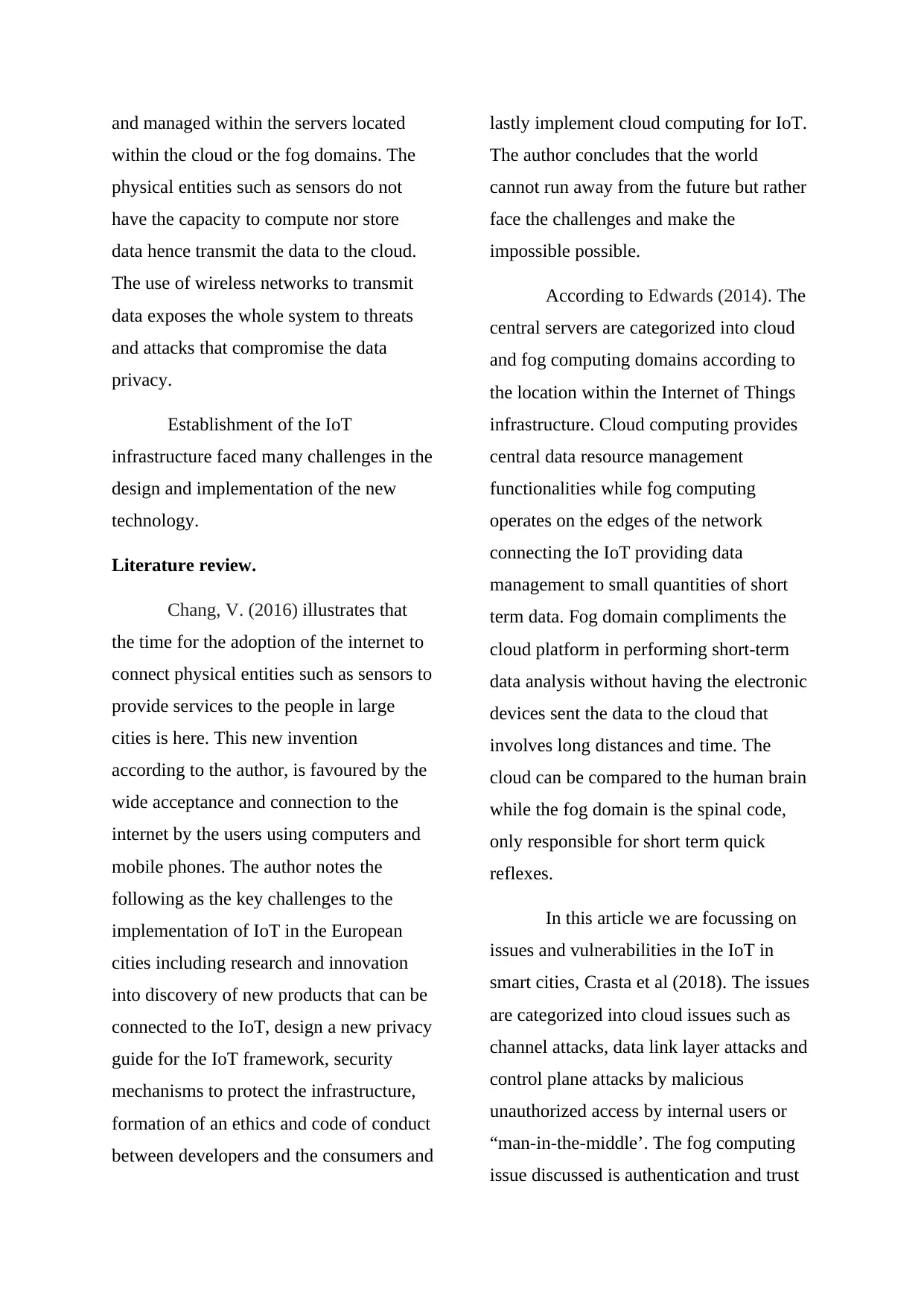
and managed within the servers located
within the cloud or the fog domains. The
physical entities such as sensors do not
have the capacity to compute nor store
data hence transmit the data to the cloud.
The use of wireless networks to transmit
data exposes the whole system to threats
and attacks that compromise the data
privacy.
Establishment of the IoT
infrastructure faced many challenges in the
design and implementation of the new
technology.
Literature review.
Chang, V. (2016) illustrates that
the time for the adoption of the internet to
connect physical entities such as sensors to
provide services to the people in large
cities is here. This new invention
according to the author, is favoured by the
wide acceptance and connection to the
internet by the users using computers and
mobile phones. The author notes the
following as the key challenges to the
implementation of IoT in the European
cities including research and innovation
into discovery of new products that can be
connected to the IoT, design a new privacy
guide for the IoT framework, security
mechanisms to protect the infrastructure,
formation of an ethics and code of conduct
between developers and the consumers and
lastly implement cloud computing for IoT.
The author concludes that the world
cannot run away from the future but rather
face the challenges and make the
impossible possible.
According to Edwards (2014). The
central servers are categorized into cloud
and fog computing domains according to
the location within the Internet of Things
infrastructure. Cloud computing provides
central data resource management
functionalities while fog computing
operates on the edges of the network
connecting the IoT providing data
management to small quantities of short
term data. Fog domain compliments the
cloud platform in performing short-term
data analysis without having the electronic
devices sent the data to the cloud that
involves long distances and time. The
cloud can be compared to the human brain
while the fog domain is the spinal code,
only responsible for short term quick
reflexes.
In this article we are focussing on
issues and vulnerabilities in the IoT in
smart cities, Crasta et al (2018). The issues
are categorized into cloud issues such as
channel attacks, data link layer attacks and
control plane attacks by malicious
unauthorized access by internal users or
“man-in-the-middle’. The fog computing
issue discussed is authentication and trust
within the cloud or the fog domains. The
physical entities such as sensors do not
have the capacity to compute nor store
data hence transmit the data to the cloud.
The use of wireless networks to transmit
data exposes the whole system to threats
and attacks that compromise the data
privacy.
Establishment of the IoT
infrastructure faced many challenges in the
design and implementation of the new
technology.
Literature review.
Chang, V. (2016) illustrates that
the time for the adoption of the internet to
connect physical entities such as sensors to
provide services to the people in large
cities is here. This new invention
according to the author, is favoured by the
wide acceptance and connection to the
internet by the users using computers and
mobile phones. The author notes the
following as the key challenges to the
implementation of IoT in the European
cities including research and innovation
into discovery of new products that can be
connected to the IoT, design a new privacy
guide for the IoT framework, security
mechanisms to protect the infrastructure,
formation of an ethics and code of conduct
between developers and the consumers and
lastly implement cloud computing for IoT.
The author concludes that the world
cannot run away from the future but rather
face the challenges and make the
impossible possible.
According to Edwards (2014). The
central servers are categorized into cloud
and fog computing domains according to
the location within the Internet of Things
infrastructure. Cloud computing provides
central data resource management
functionalities while fog computing
operates on the edges of the network
connecting the IoT providing data
management to small quantities of short
term data. Fog domain compliments the
cloud platform in performing short-term
data analysis without having the electronic
devices sent the data to the cloud that
involves long distances and time. The
cloud can be compared to the human brain
while the fog domain is the spinal code,
only responsible for short term quick
reflexes.
In this article we are focussing on
issues and vulnerabilities in the IoT in
smart cities, Crasta et al (2018). The issues
are categorized into cloud issues such as
channel attacks, data link layer attacks and
control plane attacks by malicious
unauthorized access by internal users or
“man-in-the-middle’. The fog computing
issue discussed is authentication and trust
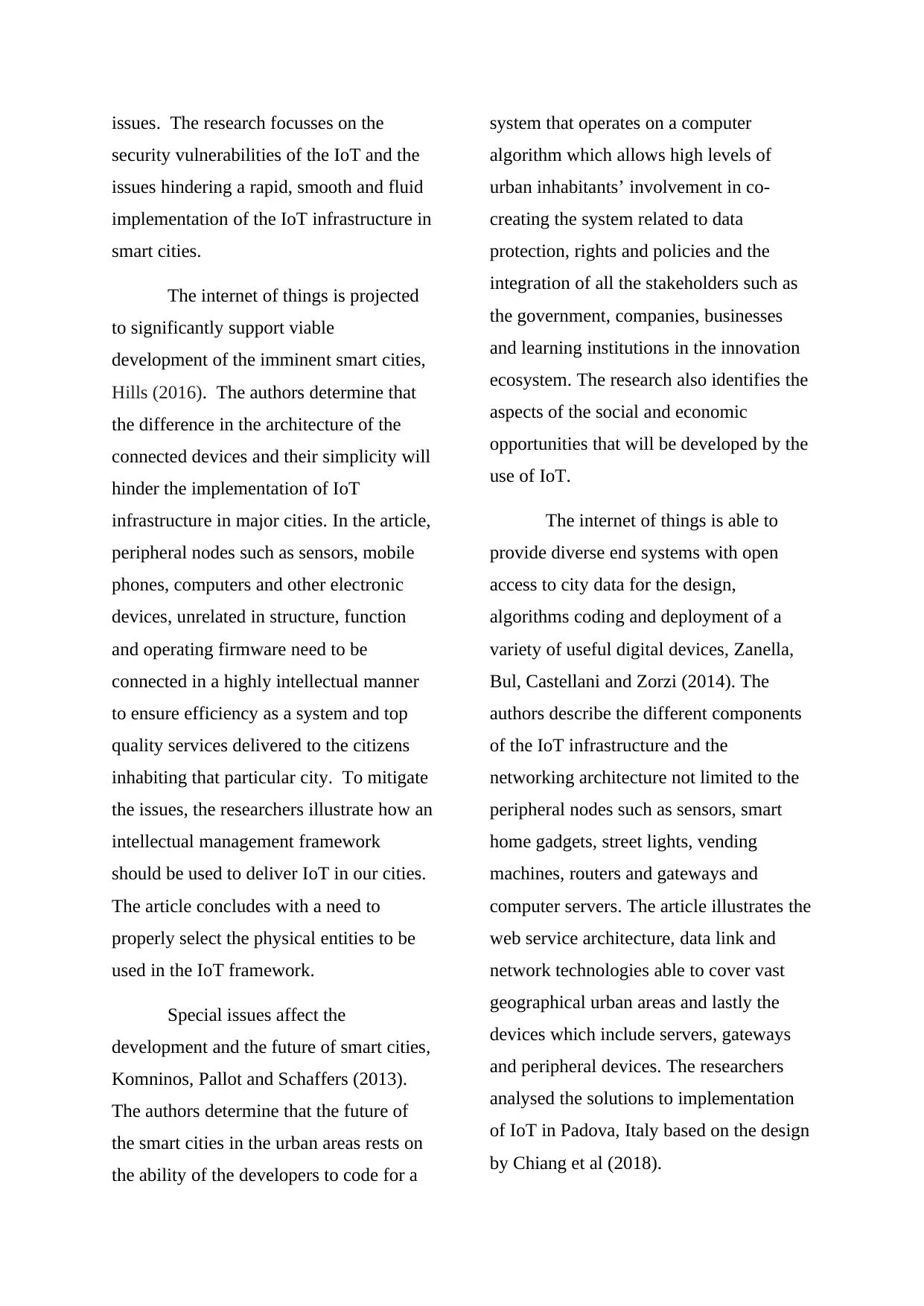
issues. The research focusses on the
security vulnerabilities of the IoT and the
issues hindering a rapid, smooth and fluid
implementation of the IoT infrastructure in
smart cities.
The internet of things is projected
to significantly support viable
development of the imminent smart cities,
Hills (2016). The authors determine that
the difference in the architecture of the
connected devices and their simplicity will
hinder the implementation of IoT
infrastructure in major cities. In the article,
peripheral nodes such as sensors, mobile
phones, computers and other electronic
devices, unrelated in structure, function
and operating firmware need to be
connected in a highly intellectual manner
to ensure efficiency as a system and top
quality services delivered to the citizens
inhabiting that particular city. To mitigate
the issues, the researchers illustrate how an
intellectual management framework
should be used to deliver IoT in our cities.
The article concludes with a need to
properly select the physical entities to be
used in the IoT framework.
Special issues affect the
development and the future of smart cities,
Komninos, Pallot and Schaffers (2013).
The authors determine that the future of
the smart cities in the urban areas rests on
the ability of the developers to code for a
system that operates on a computer
algorithm which allows high levels of
urban inhabitants’ involvement in co-
creating the system related to data
protection, rights and policies and the
integration of all the stakeholders such as
the government, companies, businesses
and learning institutions in the innovation
ecosystem. The research also identifies the
aspects of the social and economic
opportunities that will be developed by the
use of IoT.
The internet of things is able to
provide diverse end systems with open
access to city data for the design,
algorithms coding and deployment of a
variety of useful digital devices, Zanella,
Bul, Castellani and Zorzi (2014). The
authors describe the different components
of the IoT infrastructure and the
networking architecture not limited to the
peripheral nodes such as sensors, smart
home gadgets, street lights, vending
machines, routers and gateways and
computer servers. The article illustrates the
web service architecture, data link and
network technologies able to cover vast
geographical urban areas and lastly the
devices which include servers, gateways
and peripheral devices. The researchers
analysed the solutions to implementation
of IoT in Padova, Italy based on the design
by Chiang et al (2018).
security vulnerabilities of the IoT and the
issues hindering a rapid, smooth and fluid
implementation of the IoT infrastructure in
smart cities.
The internet of things is projected
to significantly support viable
development of the imminent smart cities,
Hills (2016). The authors determine that
the difference in the architecture of the
connected devices and their simplicity will
hinder the implementation of IoT
infrastructure in major cities. In the article,
peripheral nodes such as sensors, mobile
phones, computers and other electronic
devices, unrelated in structure, function
and operating firmware need to be
connected in a highly intellectual manner
to ensure efficiency as a system and top
quality services delivered to the citizens
inhabiting that particular city. To mitigate
the issues, the researchers illustrate how an
intellectual management framework
should be used to deliver IoT in our cities.
The article concludes with a need to
properly select the physical entities to be
used in the IoT framework.
Special issues affect the
development and the future of smart cities,
Komninos, Pallot and Schaffers (2013).
The authors determine that the future of
the smart cities in the urban areas rests on
the ability of the developers to code for a
system that operates on a computer
algorithm which allows high levels of
urban inhabitants’ involvement in co-
creating the system related to data
protection, rights and policies and the
integration of all the stakeholders such as
the government, companies, businesses
and learning institutions in the innovation
ecosystem. The research also identifies the
aspects of the social and economic
opportunities that will be developed by the
use of IoT.
The internet of things is able to
provide diverse end systems with open
access to city data for the design,
algorithms coding and deployment of a
variety of useful digital devices, Zanella,
Bul, Castellani and Zorzi (2014). The
authors describe the different components
of the IoT infrastructure and the
networking architecture not limited to the
peripheral nodes such as sensors, smart
home gadgets, street lights, vending
machines, routers and gateways and
computer servers. The article illustrates the
web service architecture, data link and
network technologies able to cover vast
geographical urban areas and lastly the
devices which include servers, gateways
and peripheral devices. The researchers
analysed the solutions to implementation
of IoT in Padova, Italy based on the design
by Chiang et al (2018).
Secure Best Marks with AI Grader
Need help grading? Try our AI Grader for instant feedback on your assignments.
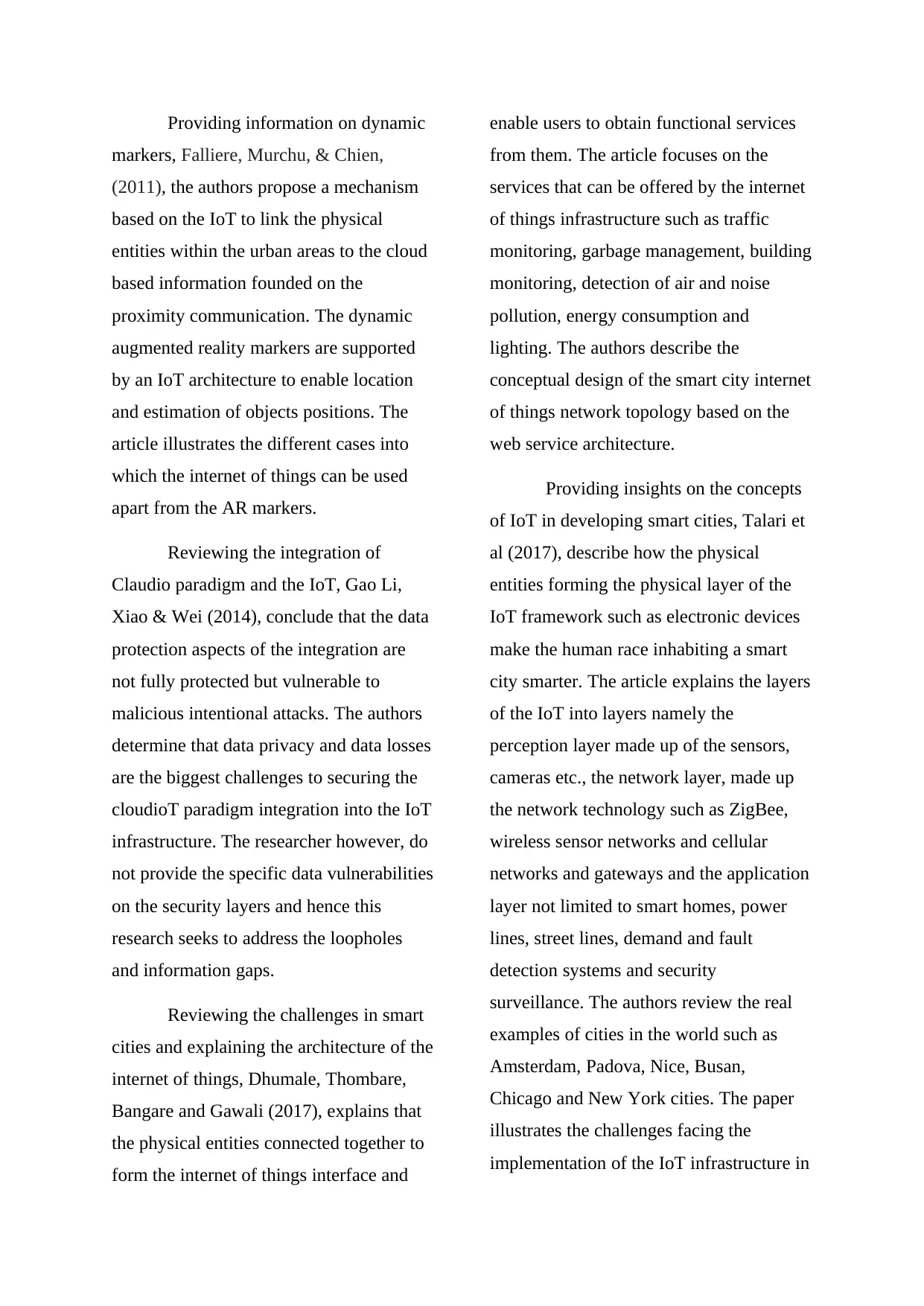
Providing information on dynamic
markers, Falliere, Murchu, & Chien,
(2011), the authors propose a mechanism
based on the IoT to link the physical
entities within the urban areas to the cloud
based information founded on the
proximity communication. The dynamic
augmented reality markers are supported
by an IoT architecture to enable location
and estimation of objects positions. The
article illustrates the different cases into
which the internet of things can be used
apart from the AR markers.
Reviewing the integration of
Claudio paradigm and the IoT, Gao Li,
Xiao & Wei (2014), conclude that the data
protection aspects of the integration are
not fully protected but vulnerable to
malicious intentional attacks. The authors
determine that data privacy and data losses
are the biggest challenges to securing the
cloudioT paradigm integration into the IoT
infrastructure. The researcher however, do
not provide the specific data vulnerabilities
on the security layers and hence this
research seeks to address the loopholes
and information gaps.
Reviewing the challenges in smart
cities and explaining the architecture of the
internet of things, Dhumale, Thombare,
Bangare and Gawali (2017), explains that
the physical entities connected together to
form the internet of things interface and
enable users to obtain functional services
from them. The article focuses on the
services that can be offered by the internet
of things infrastructure such as traffic
monitoring, garbage management, building
monitoring, detection of air and noise
pollution, energy consumption and
lighting. The authors describe the
conceptual design of the smart city internet
of things network topology based on the
web service architecture.
Providing insights on the concepts
of IoT in developing smart cities, Talari et
al (2017), describe how the physical
entities forming the physical layer of the
IoT framework such as electronic devices
make the human race inhabiting a smart
city smarter. The article explains the layers
of the IoT into layers namely the
perception layer made up of the sensors,
cameras etc., the network layer, made up
the network technology such as ZigBee,
wireless sensor networks and cellular
networks and gateways and the application
layer not limited to smart homes, power
lines, street lines, demand and fault
detection systems and security
surveillance. The authors review the real
examples of cities in the world such as
Amsterdam, Padova, Nice, Busan,
Chicago and New York cities. The paper
illustrates the challenges facing the
implementation of the IoT infrastructure in
markers, Falliere, Murchu, & Chien,
(2011), the authors propose a mechanism
based on the IoT to link the physical
entities within the urban areas to the cloud
based information founded on the
proximity communication. The dynamic
augmented reality markers are supported
by an IoT architecture to enable location
and estimation of objects positions. The
article illustrates the different cases into
which the internet of things can be used
apart from the AR markers.
Reviewing the integration of
Claudio paradigm and the IoT, Gao Li,
Xiao & Wei (2014), conclude that the data
protection aspects of the integration are
not fully protected but vulnerable to
malicious intentional attacks. The authors
determine that data privacy and data losses
are the biggest challenges to securing the
cloudioT paradigm integration into the IoT
infrastructure. The researcher however, do
not provide the specific data vulnerabilities
on the security layers and hence this
research seeks to address the loopholes
and information gaps.
Reviewing the challenges in smart
cities and explaining the architecture of the
internet of things, Dhumale, Thombare,
Bangare and Gawali (2017), explains that
the physical entities connected together to
form the internet of things interface and
enable users to obtain functional services
from them. The article focuses on the
services that can be offered by the internet
of things infrastructure such as traffic
monitoring, garbage management, building
monitoring, detection of air and noise
pollution, energy consumption and
lighting. The authors describe the
conceptual design of the smart city internet
of things network topology based on the
web service architecture.
Providing insights on the concepts
of IoT in developing smart cities, Talari et
al (2017), describe how the physical
entities forming the physical layer of the
IoT framework such as electronic devices
make the human race inhabiting a smart
city smarter. The article explains the layers
of the IoT into layers namely the
perception layer made up of the sensors,
cameras etc., the network layer, made up
the network technology such as ZigBee,
wireless sensor networks and cellular
networks and gateways and the application
layer not limited to smart homes, power
lines, street lines, demand and fault
detection systems and security
surveillance. The authors review the real
examples of cities in the world such as
Amsterdam, Padova, Nice, Busan,
Chicago and New York cities. The paper
illustrates the challenges facing the
implementation of the IoT infrastructure in
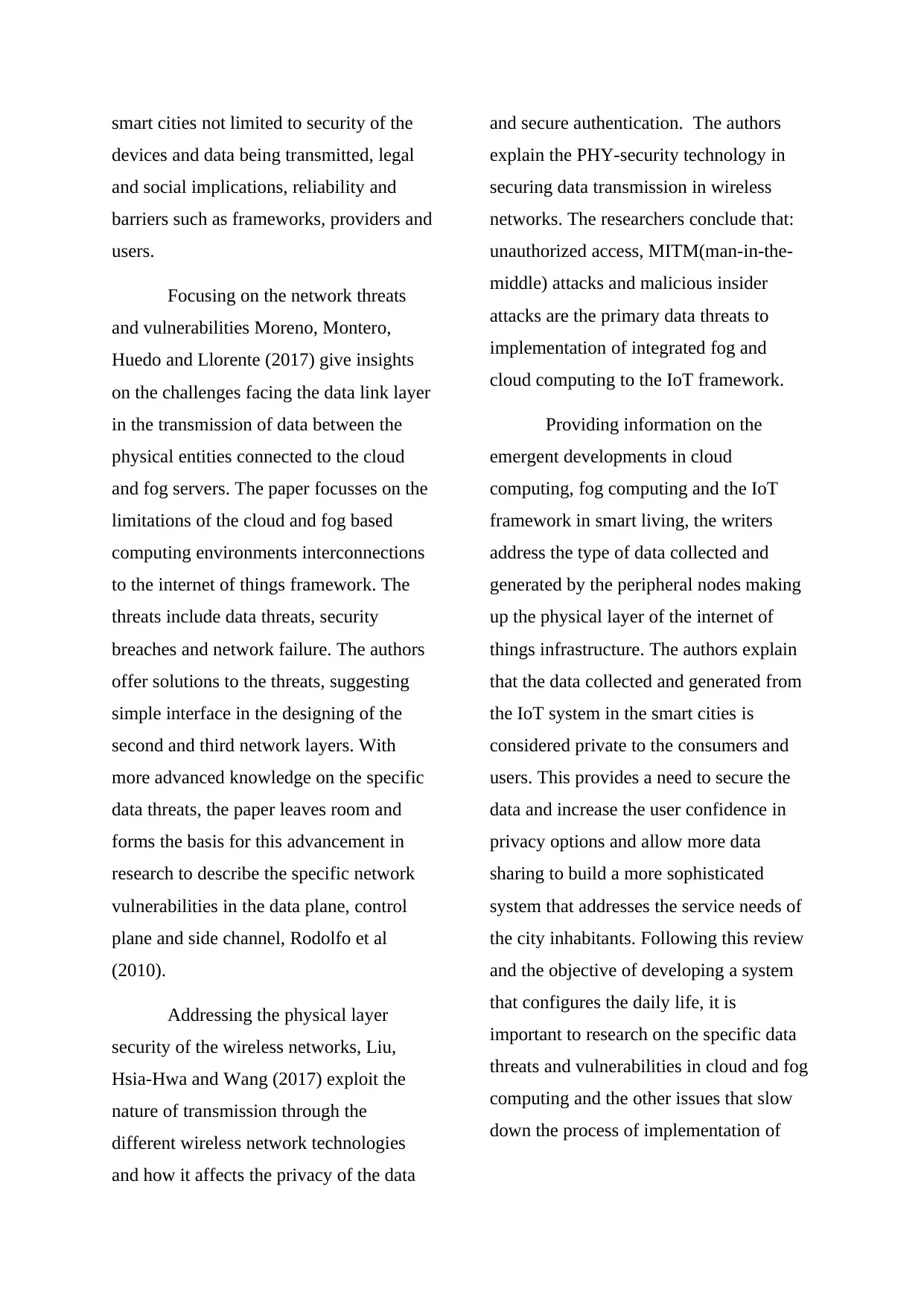
smart cities not limited to security of the
devices and data being transmitted, legal
and social implications, reliability and
barriers such as frameworks, providers and
users.
Focusing on the network threats
and vulnerabilities Moreno, Montero,
Huedo and Llorente (2017) give insights
on the challenges facing the data link layer
in the transmission of data between the
physical entities connected to the cloud
and fog servers. The paper focusses on the
limitations of the cloud and fog based
computing environments interconnections
to the internet of things framework. The
threats include data threats, security
breaches and network failure. The authors
offer solutions to the threats, suggesting
simple interface in the designing of the
second and third network layers. With
more advanced knowledge on the specific
data threats, the paper leaves room and
forms the basis for this advancement in
research to describe the specific network
vulnerabilities in the data plane, control
plane and side channel, Rodolfo et al
(2010).
Addressing the physical layer
security of the wireless networks, Liu,
Hsia-Hwa and Wang (2017) exploit the
nature of transmission through the
different wireless network technologies
and how it affects the privacy of the data
and secure authentication. The authors
explain the PHY-security technology in
securing data transmission in wireless
networks. The researchers conclude that:
unauthorized access, MITM(man-in-the-
middle) attacks and malicious insider
attacks are the primary data threats to
implementation of integrated fog and
cloud computing to the IoT framework.
Providing information on the
emergent developments in cloud
computing, fog computing and the IoT
framework in smart living, the writers
address the type of data collected and
generated by the peripheral nodes making
up the physical layer of the internet of
things infrastructure. The authors explain
that the data collected and generated from
the IoT system in the smart cities is
considered private to the consumers and
users. This provides a need to secure the
data and increase the user confidence in
privacy options and allow more data
sharing to build a more sophisticated
system that addresses the service needs of
the city inhabitants. Following this review
and the objective of developing a system
that configures the daily life, it is
important to research on the specific data
threats and vulnerabilities in cloud and fog
computing and the other issues that slow
down the process of implementation of
devices and data being transmitted, legal
and social implications, reliability and
barriers such as frameworks, providers and
users.
Focusing on the network threats
and vulnerabilities Moreno, Montero,
Huedo and Llorente (2017) give insights
on the challenges facing the data link layer
in the transmission of data between the
physical entities connected to the cloud
and fog servers. The paper focusses on the
limitations of the cloud and fog based
computing environments interconnections
to the internet of things framework. The
threats include data threats, security
breaches and network failure. The authors
offer solutions to the threats, suggesting
simple interface in the designing of the
second and third network layers. With
more advanced knowledge on the specific
data threats, the paper leaves room and
forms the basis for this advancement in
research to describe the specific network
vulnerabilities in the data plane, control
plane and side channel, Rodolfo et al
(2010).
Addressing the physical layer
security of the wireless networks, Liu,
Hsia-Hwa and Wang (2017) exploit the
nature of transmission through the
different wireless network technologies
and how it affects the privacy of the data
and secure authentication. The authors
explain the PHY-security technology in
securing data transmission in wireless
networks. The researchers conclude that:
unauthorized access, MITM(man-in-the-
middle) attacks and malicious insider
attacks are the primary data threats to
implementation of integrated fog and
cloud computing to the IoT framework.
Providing information on the
emergent developments in cloud
computing, fog computing and the IoT
framework in smart living, the writers
address the type of data collected and
generated by the peripheral nodes making
up the physical layer of the internet of
things infrastructure. The authors explain
that the data collected and generated from
the IoT system in the smart cities is
considered private to the consumers and
users. This provides a need to secure the
data and increase the user confidence in
privacy options and allow more data
sharing to build a more sophisticated
system that addresses the service needs of
the city inhabitants. Following this review
and the objective of developing a system
that configures the daily life, it is
important to research on the specific data
threats and vulnerabilities in cloud and fog
computing and the other issues that slow
down the process of implementation of
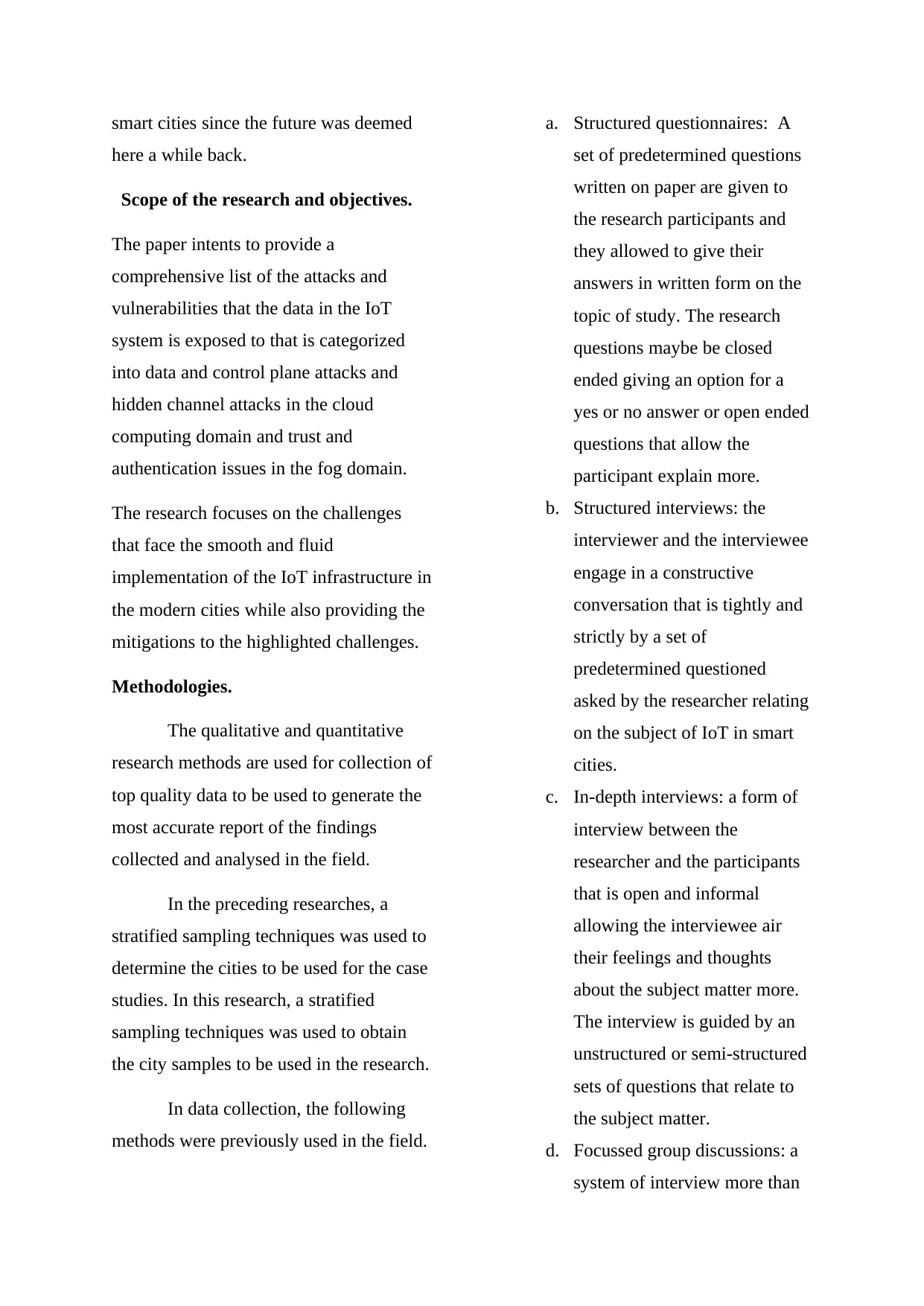
smart cities since the future was deemed
here a while back.
Scope of the research and objectives.
The paper intents to provide a
comprehensive list of the attacks and
vulnerabilities that the data in the IoT
system is exposed to that is categorized
into data and control plane attacks and
hidden channel attacks in the cloud
computing domain and trust and
authentication issues in the fog domain.
The research focuses on the challenges
that face the smooth and fluid
implementation of the IoT infrastructure in
the modern cities while also providing the
mitigations to the highlighted challenges.
Methodologies.
The qualitative and quantitative
research methods are used for collection of
top quality data to be used to generate the
most accurate report of the findings
collected and analysed in the field.
In the preceding researches, a
stratified sampling techniques was used to
determine the cities to be used for the case
studies. In this research, a stratified
sampling techniques was used to obtain
the city samples to be used in the research.
In data collection, the following
methods were previously used in the field.
a. Structured questionnaires: A
set of predetermined questions
written on paper are given to
the research participants and
they allowed to give their
answers in written form on the
topic of study. The research
questions maybe be closed
ended giving an option for a
yes or no answer or open ended
questions that allow the
participant explain more.
b. Structured interviews: the
interviewer and the interviewee
engage in a constructive
conversation that is tightly and
strictly by a set of
predetermined questioned
asked by the researcher relating
on the subject of IoT in smart
cities.
c. In-depth interviews: a form of
interview between the
researcher and the participants
that is open and informal
allowing the interviewee air
their feelings and thoughts
about the subject matter more.
The interview is guided by an
unstructured or semi-structured
sets of questions that relate to
the subject matter.
d. Focussed group discussions: a
system of interview more than
here a while back.
Scope of the research and objectives.
The paper intents to provide a
comprehensive list of the attacks and
vulnerabilities that the data in the IoT
system is exposed to that is categorized
into data and control plane attacks and
hidden channel attacks in the cloud
computing domain and trust and
authentication issues in the fog domain.
The research focuses on the challenges
that face the smooth and fluid
implementation of the IoT infrastructure in
the modern cities while also providing the
mitigations to the highlighted challenges.
Methodologies.
The qualitative and quantitative
research methods are used for collection of
top quality data to be used to generate the
most accurate report of the findings
collected and analysed in the field.
In the preceding researches, a
stratified sampling techniques was used to
determine the cities to be used for the case
studies. In this research, a stratified
sampling techniques was used to obtain
the city samples to be used in the research.
In data collection, the following
methods were previously used in the field.
a. Structured questionnaires: A
set of predetermined questions
written on paper are given to
the research participants and
they allowed to give their
answers in written form on the
topic of study. The research
questions maybe be closed
ended giving an option for a
yes or no answer or open ended
questions that allow the
participant explain more.
b. Structured interviews: the
interviewer and the interviewee
engage in a constructive
conversation that is tightly and
strictly by a set of
predetermined questioned
asked by the researcher relating
on the subject of IoT in smart
cities.
c. In-depth interviews: a form of
interview between the
researcher and the participants
that is open and informal
allowing the interviewee air
their feelings and thoughts
about the subject matter more.
The interview is guided by an
unstructured or semi-structured
sets of questions that relate to
the subject matter.
d. Focussed group discussions: a
system of interview more than
Paraphrase This Document
Need a fresh take? Get an instant paraphrase of this document with our AI Paraphraser
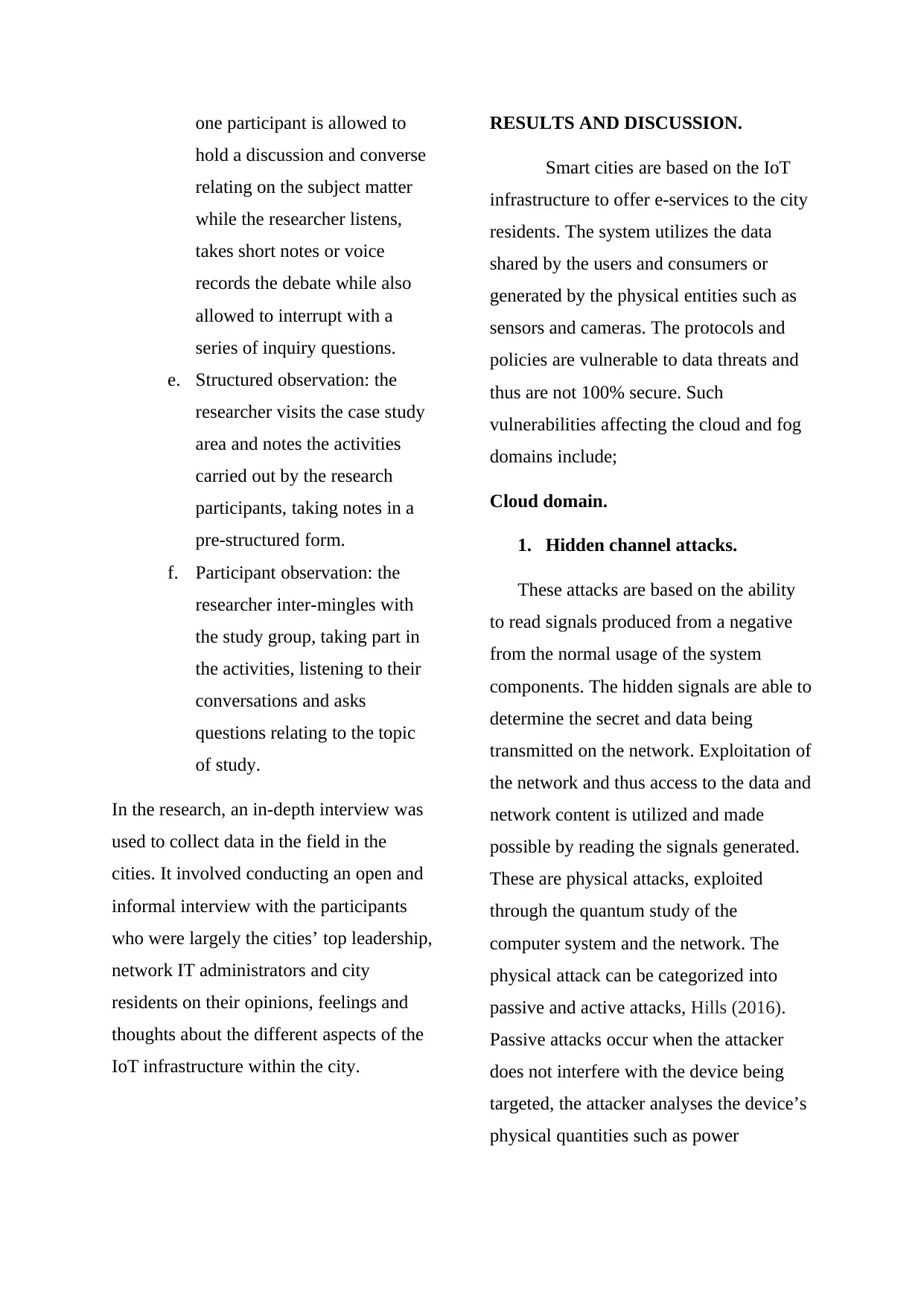
one participant is allowed to
hold a discussion and converse
relating on the subject matter
while the researcher listens,
takes short notes or voice
records the debate while also
allowed to interrupt with a
series of inquiry questions.
e. Structured observation: the
researcher visits the case study
area and notes the activities
carried out by the research
participants, taking notes in a
pre-structured form.
f. Participant observation: the
researcher inter-mingles with
the study group, taking part in
the activities, listening to their
conversations and asks
questions relating to the topic
of study.
In the research, an in-depth interview was
used to collect data in the field in the
cities. It involved conducting an open and
informal interview with the participants
who were largely the cities’ top leadership,
network IT administrators and city
residents on their opinions, feelings and
thoughts about the different aspects of the
IoT infrastructure within the city.
RESULTS AND DISCUSSION.
Smart cities are based on the IoT
infrastructure to offer e-services to the city
residents. The system utilizes the data
shared by the users and consumers or
generated by the physical entities such as
sensors and cameras. The protocols and
policies are vulnerable to data threats and
thus are not 100% secure. Such
vulnerabilities affecting the cloud and fog
domains include;
Cloud domain.
1. Hidden channel attacks.
These attacks are based on the ability
to read signals produced from a negative
from the normal usage of the system
components. The hidden signals are able to
determine the secret and data being
transmitted on the network. Exploitation of
the network and thus access to the data and
network content is utilized and made
possible by reading the signals generated.
These are physical attacks, exploited
through the quantum study of the
computer system and the network. The
physical attack can be categorized into
passive and active attacks, Hills (2016).
Passive attacks occur when the attacker
does not interfere with the device being
targeted, the attacker analyses the device’s
physical quantities such as power
hold a discussion and converse
relating on the subject matter
while the researcher listens,
takes short notes or voice
records the debate while also
allowed to interrupt with a
series of inquiry questions.
e. Structured observation: the
researcher visits the case study
area and notes the activities
carried out by the research
participants, taking notes in a
pre-structured form.
f. Participant observation: the
researcher inter-mingles with
the study group, taking part in
the activities, listening to their
conversations and asks
questions relating to the topic
of study.
In the research, an in-depth interview was
used to collect data in the field in the
cities. It involved conducting an open and
informal interview with the participants
who were largely the cities’ top leadership,
network IT administrators and city
residents on their opinions, feelings and
thoughts about the different aspects of the
IoT infrastructure within the city.
RESULTS AND DISCUSSION.
Smart cities are based on the IoT
infrastructure to offer e-services to the city
residents. The system utilizes the data
shared by the users and consumers or
generated by the physical entities such as
sensors and cameras. The protocols and
policies are vulnerable to data threats and
thus are not 100% secure. Such
vulnerabilities affecting the cloud and fog
domains include;
Cloud domain.
1. Hidden channel attacks.
These attacks are based on the ability
to read signals produced from a negative
from the normal usage of the system
components. The hidden signals are able to
determine the secret and data being
transmitted on the network. Exploitation of
the network and thus access to the data and
network content is utilized and made
possible by reading the signals generated.
These are physical attacks, exploited
through the quantum study of the
computer system and the network. The
physical attack can be categorized into
passive and active attacks, Hills (2016).
Passive attacks occur when the attacker
does not interfere with the device being
targeted, the attacker analyses the device’s
physical quantities such as power
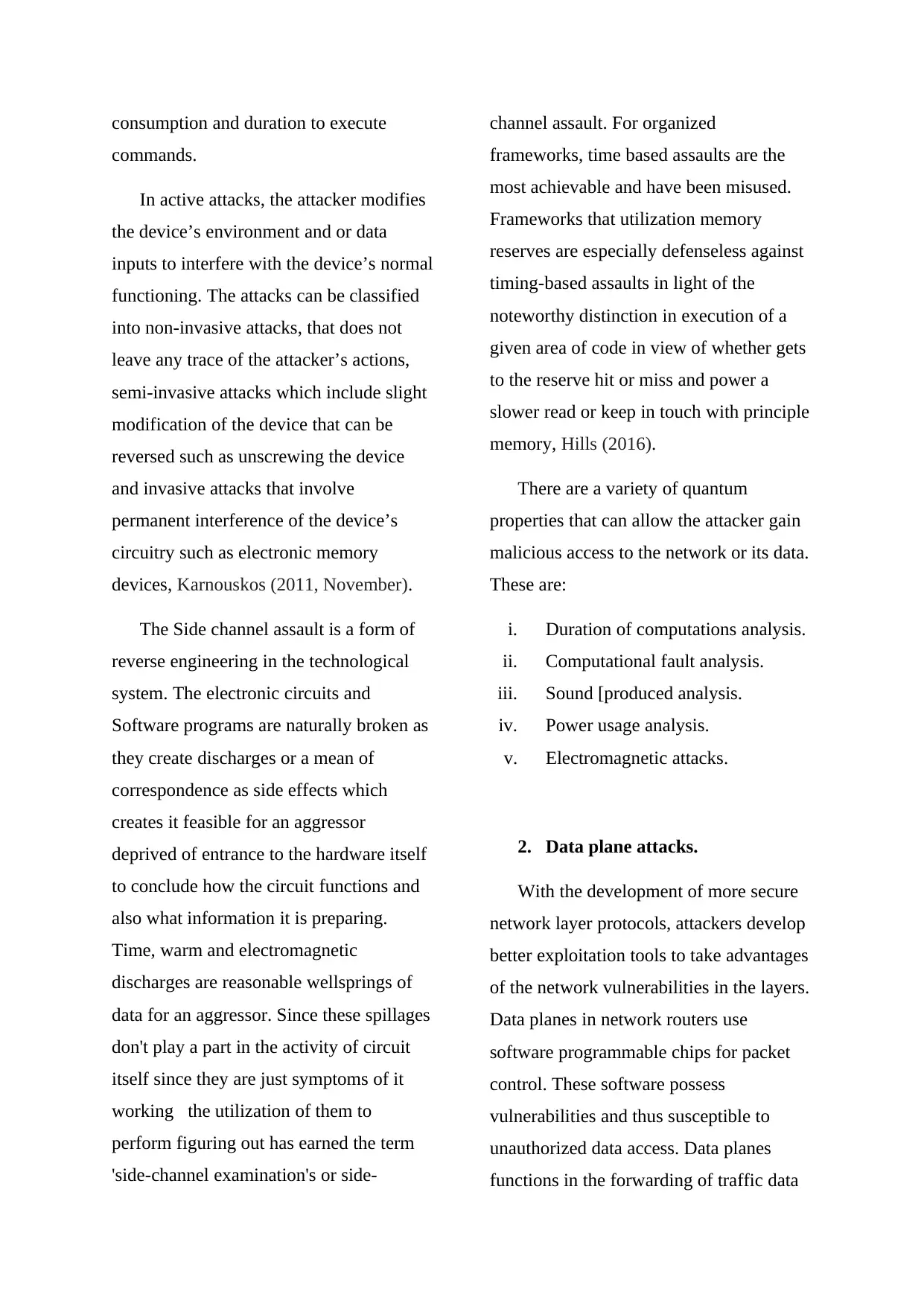
consumption and duration to execute
commands.
In active attacks, the attacker modifies
the device’s environment and or data
inputs to interfere with the device’s normal
functioning. The attacks can be classified
into non-invasive attacks, that does not
leave any trace of the attacker’s actions,
semi-invasive attacks which include slight
modification of the device that can be
reversed such as unscrewing the device
and invasive attacks that involve
permanent interference of the device’s
circuitry such as electronic memory
devices, Karnouskos (2011, November).
The Side channel assault is a form of
reverse engineering in the technological
system. The electronic circuits and
Software programs are naturally broken as
they create discharges or a mean of
correspondence as side effects which
creates it feasible for an aggressor
deprived of entrance to the hardware itself
to conclude how the circuit functions and
also what information it is preparing.
Time, warm and electromagnetic
discharges are reasonable wellsprings of
data for an aggressor. Since these spillages
don't play a part in the activity of circuit
itself since they are just symptoms of it
working the utilization of them to
perform figuring out has earned the term
'side-channel examination's or side-
channel assault. For organized
frameworks, time based assaults are the
most achievable and have been misused.
Frameworks that utilization memory
reserves are especially defenseless against
timing-based assaults in light of the
noteworthy distinction in execution of a
given area of code in view of whether gets
to the reserve hit or miss and power a
slower read or keep in touch with principle
memory, Hills (2016).
There are a variety of quantum
properties that can allow the attacker gain
malicious access to the network or its data.
These are:
i. Duration of computations analysis.
ii. Computational fault analysis.
iii. Sound [produced analysis.
iv. Power usage analysis.
v. Electromagnetic attacks.
2. Data plane attacks.
With the development of more secure
network layer protocols, attackers develop
better exploitation tools to take advantages
of the network vulnerabilities in the layers.
Data planes in network routers use
software programmable chips for packet
control. These software possess
vulnerabilities and thus susceptible to
unauthorized data access. Data planes
functions in the forwarding of traffic data
commands.
In active attacks, the attacker modifies
the device’s environment and or data
inputs to interfere with the device’s normal
functioning. The attacks can be classified
into non-invasive attacks, that does not
leave any trace of the attacker’s actions,
semi-invasive attacks which include slight
modification of the device that can be
reversed such as unscrewing the device
and invasive attacks that involve
permanent interference of the device’s
circuitry such as electronic memory
devices, Karnouskos (2011, November).
The Side channel assault is a form of
reverse engineering in the technological
system. The electronic circuits and
Software programs are naturally broken as
they create discharges or a mean of
correspondence as side effects which
creates it feasible for an aggressor
deprived of entrance to the hardware itself
to conclude how the circuit functions and
also what information it is preparing.
Time, warm and electromagnetic
discharges are reasonable wellsprings of
data for an aggressor. Since these spillages
don't play a part in the activity of circuit
itself since they are just symptoms of it
working the utilization of them to
perform figuring out has earned the term
'side-channel examination's or side-
channel assault. For organized
frameworks, time based assaults are the
most achievable and have been misused.
Frameworks that utilization memory
reserves are especially defenseless against
timing-based assaults in light of the
noteworthy distinction in execution of a
given area of code in view of whether gets
to the reserve hit or miss and power a
slower read or keep in touch with principle
memory, Hills (2016).
There are a variety of quantum
properties that can allow the attacker gain
malicious access to the network or its data.
These are:
i. Duration of computations analysis.
ii. Computational fault analysis.
iii. Sound [produced analysis.
iv. Power usage analysis.
v. Electromagnetic attacks.
2. Data plane attacks.
With the development of more secure
network layer protocols, attackers develop
better exploitation tools to take advantages
of the network vulnerabilities in the layers.
Data planes in network routers use
software programmable chips for packet
control. These software possess
vulnerabilities and thus susceptible to
unauthorized data access. Data planes
functions in the forwarding of traffic data
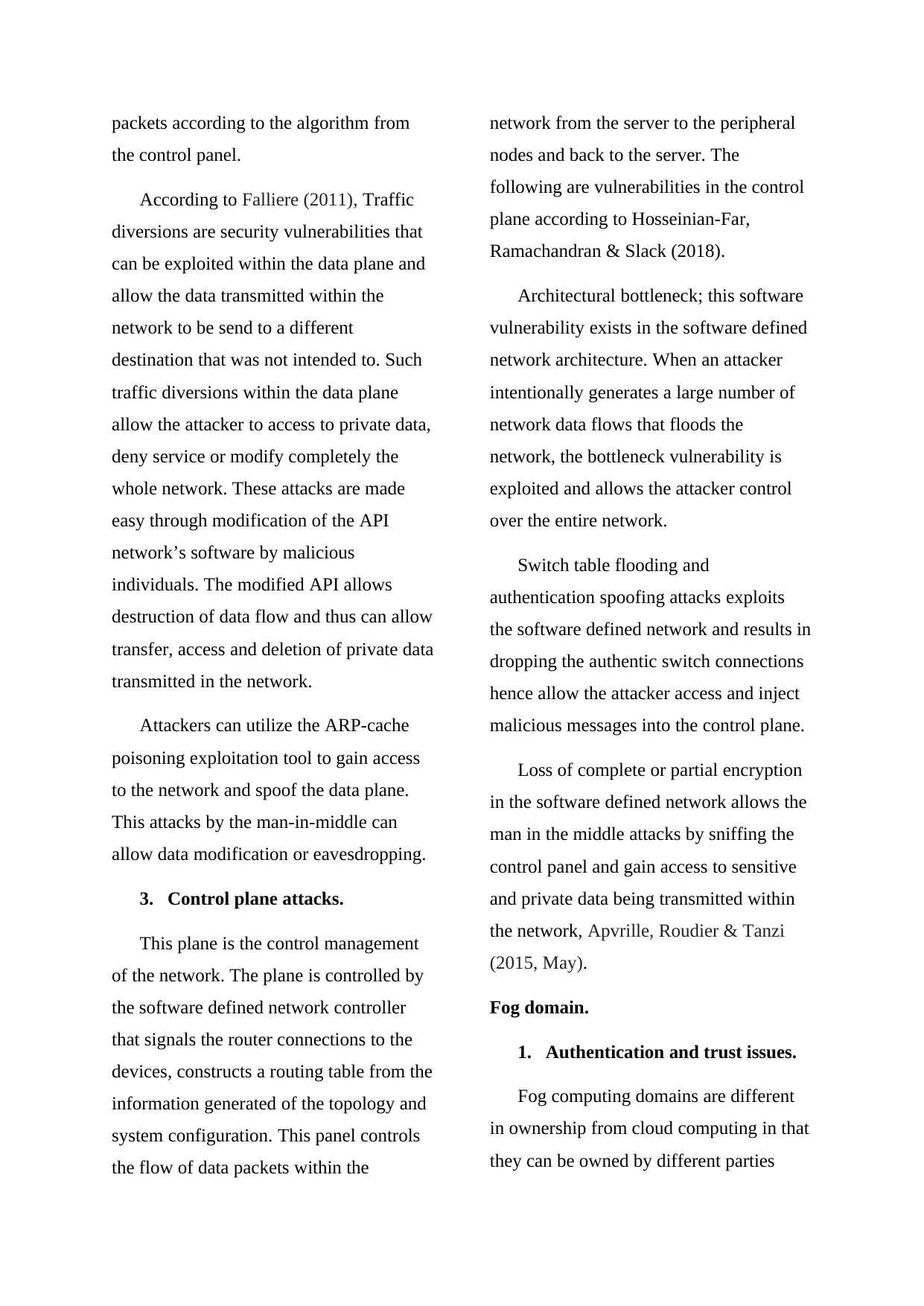
packets according to the algorithm from
the control panel.
According to Falliere (2011), Traffic
diversions are security vulnerabilities that
can be exploited within the data plane and
allow the data transmitted within the
network to be send to a different
destination that was not intended to. Such
traffic diversions within the data plane
allow the attacker to access to private data,
deny service or modify completely the
whole network. These attacks are made
easy through modification of the API
network’s software by malicious
individuals. The modified API allows
destruction of data flow and thus can allow
transfer, access and deletion of private data
transmitted in the network.
Attackers can utilize the ARP-cache
poisoning exploitation tool to gain access
to the network and spoof the data plane.
This attacks by the man-in-middle can
allow data modification or eavesdropping.
3. Control plane attacks.
This plane is the control management
of the network. The plane is controlled by
the software defined network controller
that signals the router connections to the
devices, constructs a routing table from the
information generated of the topology and
system configuration. This panel controls
the flow of data packets within the
network from the server to the peripheral
nodes and back to the server. The
following are vulnerabilities in the control
plane according to Hosseinian-Far,
Ramachandran & Slack (2018).
Architectural bottleneck; this software
vulnerability exists in the software defined
network architecture. When an attacker
intentionally generates a large number of
network data flows that floods the
network, the bottleneck vulnerability is
exploited and allows the attacker control
over the entire network.
Switch table flooding and
authentication spoofing attacks exploits
the software defined network and results in
dropping the authentic switch connections
hence allow the attacker access and inject
malicious messages into the control plane.
Loss of complete or partial encryption
in the software defined network allows the
man in the middle attacks by sniffing the
control panel and gain access to sensitive
and private data being transmitted within
the network, Apvrille, Roudier & Tanzi
(2015, May).
Fog domain.
1. Authentication and trust issues.
Fog computing domains are different
in ownership from cloud computing in that
they can be owned by different parties
the control panel.
According to Falliere (2011), Traffic
diversions are security vulnerabilities that
can be exploited within the data plane and
allow the data transmitted within the
network to be send to a different
destination that was not intended to. Such
traffic diversions within the data plane
allow the attacker to access to private data,
deny service or modify completely the
whole network. These attacks are made
easy through modification of the API
network’s software by malicious
individuals. The modified API allows
destruction of data flow and thus can allow
transfer, access and deletion of private data
transmitted in the network.
Attackers can utilize the ARP-cache
poisoning exploitation tool to gain access
to the network and spoof the data plane.
This attacks by the man-in-middle can
allow data modification or eavesdropping.
3. Control plane attacks.
This plane is the control management
of the network. The plane is controlled by
the software defined network controller
that signals the router connections to the
devices, constructs a routing table from the
information generated of the topology and
system configuration. This panel controls
the flow of data packets within the
network from the server to the peripheral
nodes and back to the server. The
following are vulnerabilities in the control
plane according to Hosseinian-Far,
Ramachandran & Slack (2018).
Architectural bottleneck; this software
vulnerability exists in the software defined
network architecture. When an attacker
intentionally generates a large number of
network data flows that floods the
network, the bottleneck vulnerability is
exploited and allows the attacker control
over the entire network.
Switch table flooding and
authentication spoofing attacks exploits
the software defined network and results in
dropping the authentic switch connections
hence allow the attacker access and inject
malicious messages into the control plane.
Loss of complete or partial encryption
in the software defined network allows the
man in the middle attacks by sniffing the
control panel and gain access to sensitive
and private data being transmitted within
the network, Apvrille, Roudier & Tanzi
(2015, May).
Fog domain.
1. Authentication and trust issues.
Fog computing domains are different
in ownership from cloud computing in that
they can be owned by different parties
Secure Best Marks with AI Grader
Need help grading? Try our AI Grader for instant feedback on your assignments.
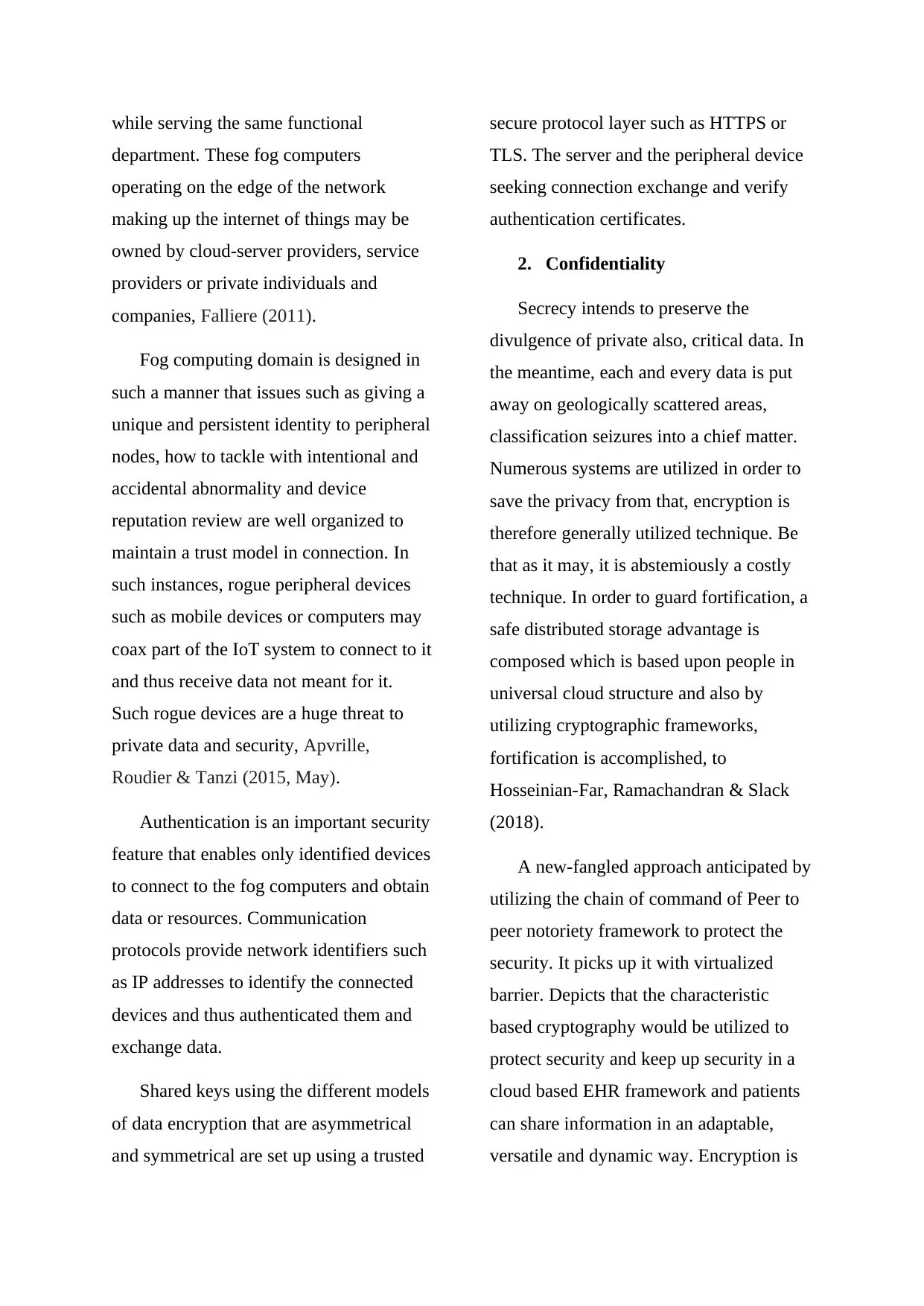
while serving the same functional
department. These fog computers
operating on the edge of the network
making up the internet of things may be
owned by cloud-server providers, service
providers or private individuals and
companies, Falliere (2011).
Fog computing domain is designed in
such a manner that issues such as giving a
unique and persistent identity to peripheral
nodes, how to tackle with intentional and
accidental abnormality and device
reputation review are well organized to
maintain a trust model in connection. In
such instances, rogue peripheral devices
such as mobile devices or computers may
coax part of the IoT system to connect to it
and thus receive data not meant for it.
Such rogue devices are a huge threat to
private data and security, Apvrille,
Roudier & Tanzi (2015, May).
Authentication is an important security
feature that enables only identified devices
to connect to the fog computers and obtain
data or resources. Communication
protocols provide network identifiers such
as IP addresses to identify the connected
devices and thus authenticated them and
exchange data.
Shared keys using the different models
of data encryption that are asymmetrical
and symmetrical are set up using a trusted
secure protocol layer such as HTTPS or
TLS. The server and the peripheral device
seeking connection exchange and verify
authentication certificates.
2. Confidentiality
Secrecy intends to preserve the
divulgence of private also, critical data. In
the meantime, each and every data is put
away on geologically scattered areas,
classification seizures into a chief matter.
Numerous systems are utilized in order to
save the privacy from that, encryption is
therefore generally utilized technique. Be
that as it may, it is abstemiously a costly
technique. In order to guard fortification, a
safe distributed storage advantage is
composed which is based upon people in
universal cloud structure and also by
utilizing cryptographic frameworks,
fortification is accomplished, to
Hosseinian-Far, Ramachandran & Slack
(2018).
A new-fangled approach anticipated by
utilizing the chain of command of Peer to
peer notoriety framework to protect the
security. It picks up it with virtualized
barrier. Depicts that the characteristic
based cryptography would be utilized to
protect security and keep up security in a
cloud based EHR framework and patients
can share information in an adaptable,
versatile and dynamic way. Encryption is
department. These fog computers
operating on the edge of the network
making up the internet of things may be
owned by cloud-server providers, service
providers or private individuals and
companies, Falliere (2011).
Fog computing domain is designed in
such a manner that issues such as giving a
unique and persistent identity to peripheral
nodes, how to tackle with intentional and
accidental abnormality and device
reputation review are well organized to
maintain a trust model in connection. In
such instances, rogue peripheral devices
such as mobile devices or computers may
coax part of the IoT system to connect to it
and thus receive data not meant for it.
Such rogue devices are a huge threat to
private data and security, Apvrille,
Roudier & Tanzi (2015, May).
Authentication is an important security
feature that enables only identified devices
to connect to the fog computers and obtain
data or resources. Communication
protocols provide network identifiers such
as IP addresses to identify the connected
devices and thus authenticated them and
exchange data.
Shared keys using the different models
of data encryption that are asymmetrical
and symmetrical are set up using a trusted
secure protocol layer such as HTTPS or
TLS. The server and the peripheral device
seeking connection exchange and verify
authentication certificates.
2. Confidentiality
Secrecy intends to preserve the
divulgence of private also, critical data. In
the meantime, each and every data is put
away on geologically scattered areas,
classification seizures into a chief matter.
Numerous systems are utilized in order to
save the privacy from that, encryption is
therefore generally utilized technique. Be
that as it may, it is abstemiously a costly
technique. In order to guard fortification, a
safe distributed storage advantage is
composed which is based upon people in
universal cloud structure and also by
utilizing cryptographic frameworks,
fortification is accomplished, to
Hosseinian-Far, Ramachandran & Slack
(2018).
A new-fangled approach anticipated by
utilizing the chain of command of Peer to
peer notoriety framework to protect the
security. It picks up it with virtualized
barrier. Depicts that the characteristic
based cryptography would be utilized to
protect security and keep up security in a
cloud based EHR framework and patients
can share information in an adaptable,
versatile and dynamic way. Encryption is
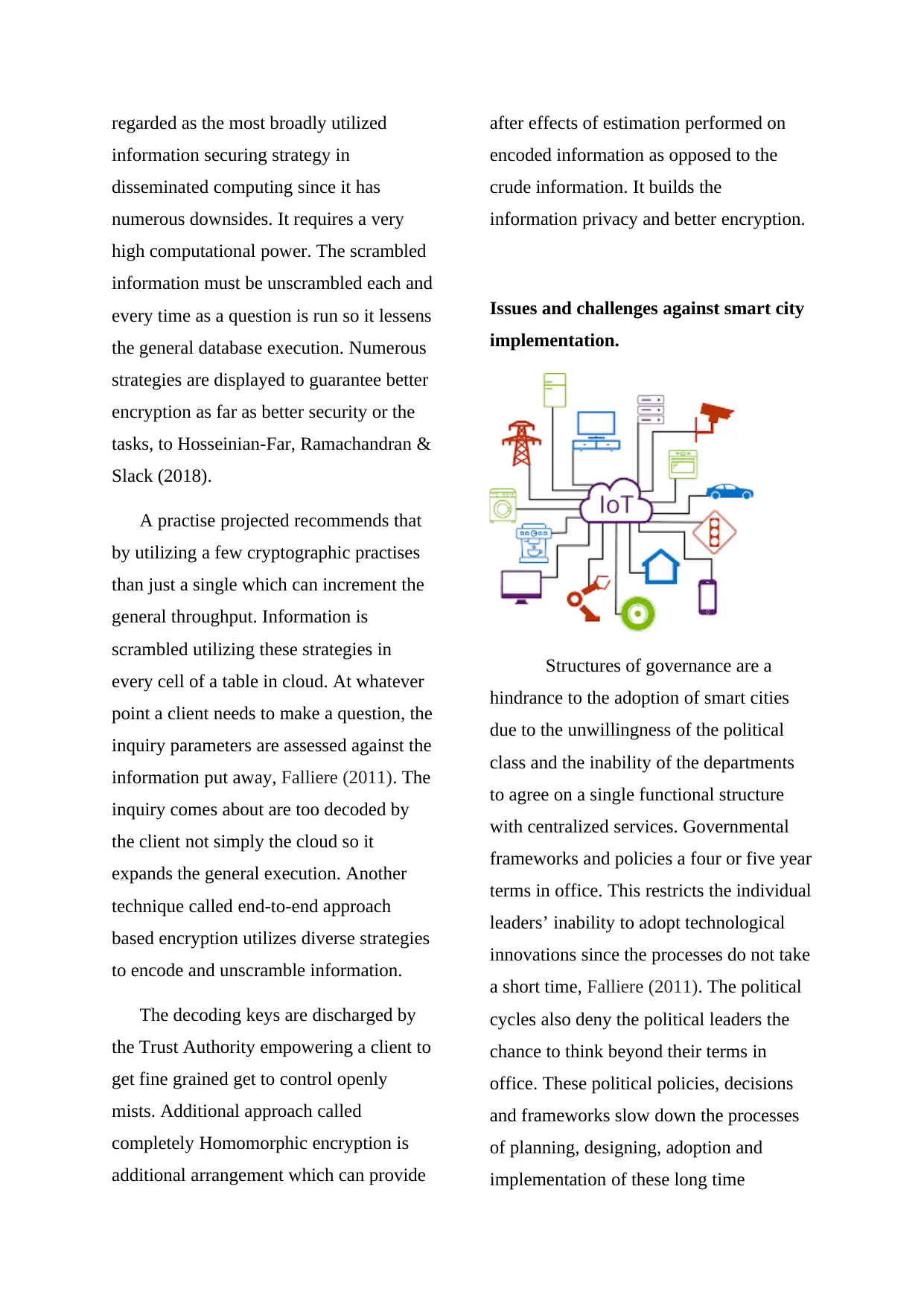
regarded as the most broadly utilized
information securing strategy in
disseminated computing since it has
numerous downsides. It requires a very
high computational power. The scrambled
information must be unscrambled each and
every time as a question is run so it lessens
the general database execution. Numerous
strategies are displayed to guarantee better
encryption as far as better security or the
tasks, to Hosseinian-Far, Ramachandran &
Slack (2018).
A practise projected recommends that
by utilizing a few cryptographic practises
than just a single which can increment the
general throughput. Information is
scrambled utilizing these strategies in
every cell of a table in cloud. At whatever
point a client needs to make a question, the
inquiry parameters are assessed against the
information put away, Falliere (2011). The
inquiry comes about are too decoded by
the client not simply the cloud so it
expands the general execution. Another
technique called end-to-end approach
based encryption utilizes diverse strategies
to encode and unscramble information.
The decoding keys are discharged by
the Trust Authority empowering a client to
get fine grained get to control openly
mists. Additional approach called
completely Homomorphic encryption is
additional arrangement which can provide
after effects of estimation performed on
encoded information as opposed to the
crude information. It builds the
information privacy and better encryption.
Issues and challenges against smart city
implementation.
Structures of governance are a
hindrance to the adoption of smart cities
due to the unwillingness of the political
class and the inability of the departments
to agree on a single functional structure
with centralized services. Governmental
frameworks and policies a four or five year
terms in office. This restricts the individual
leaders’ inability to adopt technological
innovations since the processes do not take
a short time, Falliere (2011). The political
cycles also deny the political leaders the
chance to think beyond their terms in
office. These political policies, decisions
and frameworks slow down the processes
of planning, designing, adoption and
implementation of these long time
information securing strategy in
disseminated computing since it has
numerous downsides. It requires a very
high computational power. The scrambled
information must be unscrambled each and
every time as a question is run so it lessens
the general database execution. Numerous
strategies are displayed to guarantee better
encryption as far as better security or the
tasks, to Hosseinian-Far, Ramachandran &
Slack (2018).
A practise projected recommends that
by utilizing a few cryptographic practises
than just a single which can increment the
general throughput. Information is
scrambled utilizing these strategies in
every cell of a table in cloud. At whatever
point a client needs to make a question, the
inquiry parameters are assessed against the
information put away, Falliere (2011). The
inquiry comes about are too decoded by
the client not simply the cloud so it
expands the general execution. Another
technique called end-to-end approach
based encryption utilizes diverse strategies
to encode and unscramble information.
The decoding keys are discharged by
the Trust Authority empowering a client to
get fine grained get to control openly
mists. Additional approach called
completely Homomorphic encryption is
additional arrangement which can provide
after effects of estimation performed on
encoded information as opposed to the
crude information. It builds the
information privacy and better encryption.
Issues and challenges against smart city
implementation.
Structures of governance are a
hindrance to the adoption of smart cities
due to the unwillingness of the political
class and the inability of the departments
to agree on a single functional structure
with centralized services. Governmental
frameworks and policies a four or five year
terms in office. This restricts the individual
leaders’ inability to adopt technological
innovations since the processes do not take
a short time, Falliere (2011). The political
cycles also deny the political leaders the
chance to think beyond their terms in
office. These political policies, decisions
and frameworks slow down the processes
of planning, designing, adoption and
implementation of these long time
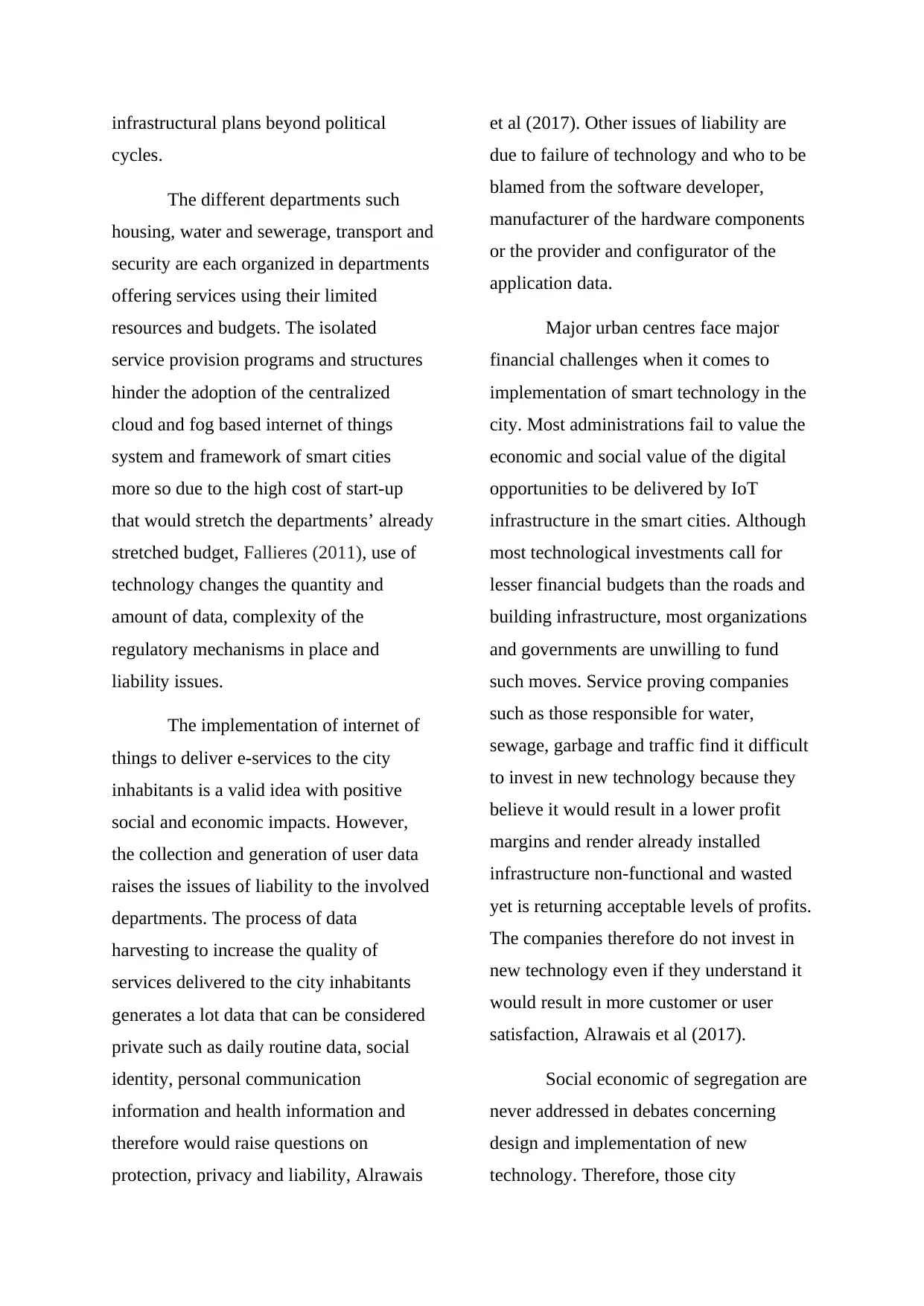
infrastructural plans beyond political
cycles.
The different departments such
housing, water and sewerage, transport and
security are each organized in departments
offering services using their limited
resources and budgets. The isolated
service provision programs and structures
hinder the adoption of the centralized
cloud and fog based internet of things
system and framework of smart cities
more so due to the high cost of start-up
that would stretch the departments’ already
stretched budget, Fallieres (2011), use of
technology changes the quantity and
amount of data, complexity of the
regulatory mechanisms in place and
liability issues.
The implementation of internet of
things to deliver e-services to the city
inhabitants is a valid idea with positive
social and economic impacts. However,
the collection and generation of user data
raises the issues of liability to the involved
departments. The process of data
harvesting to increase the quality of
services delivered to the city inhabitants
generates a lot data that can be considered
private such as daily routine data, social
identity, personal communication
information and health information and
therefore would raise questions on
protection, privacy and liability, Alrawais
et al (2017). Other issues of liability are
due to failure of technology and who to be
blamed from the software developer,
manufacturer of the hardware components
or the provider and configurator of the
application data.
Major urban centres face major
financial challenges when it comes to
implementation of smart technology in the
city. Most administrations fail to value the
economic and social value of the digital
opportunities to be delivered by IoT
infrastructure in the smart cities. Although
most technological investments call for
lesser financial budgets than the roads and
building infrastructure, most organizations
and governments are unwilling to fund
such moves. Service proving companies
such as those responsible for water,
sewage, garbage and traffic find it difficult
to invest in new technology because they
believe it would result in a lower profit
margins and render already installed
infrastructure non-functional and wasted
yet is returning acceptable levels of profits.
The companies therefore do not invest in
new technology even if they understand it
would result in more customer or user
satisfaction, Alrawais et al (2017).
Social economic of segregation are
never addressed in debates concerning
design and implementation of new
technology. Therefore, those city
cycles.
The different departments such
housing, water and sewerage, transport and
security are each organized in departments
offering services using their limited
resources and budgets. The isolated
service provision programs and structures
hinder the adoption of the centralized
cloud and fog based internet of things
system and framework of smart cities
more so due to the high cost of start-up
that would stretch the departments’ already
stretched budget, Fallieres (2011), use of
technology changes the quantity and
amount of data, complexity of the
regulatory mechanisms in place and
liability issues.
The implementation of internet of
things to deliver e-services to the city
inhabitants is a valid idea with positive
social and economic impacts. However,
the collection and generation of user data
raises the issues of liability to the involved
departments. The process of data
harvesting to increase the quality of
services delivered to the city inhabitants
generates a lot data that can be considered
private such as daily routine data, social
identity, personal communication
information and health information and
therefore would raise questions on
protection, privacy and liability, Alrawais
et al (2017). Other issues of liability are
due to failure of technology and who to be
blamed from the software developer,
manufacturer of the hardware components
or the provider and configurator of the
application data.
Major urban centres face major
financial challenges when it comes to
implementation of smart technology in the
city. Most administrations fail to value the
economic and social value of the digital
opportunities to be delivered by IoT
infrastructure in the smart cities. Although
most technological investments call for
lesser financial budgets than the roads and
building infrastructure, most organizations
and governments are unwilling to fund
such moves. Service proving companies
such as those responsible for water,
sewage, garbage and traffic find it difficult
to invest in new technology because they
believe it would result in a lower profit
margins and render already installed
infrastructure non-functional and wasted
yet is returning acceptable levels of profits.
The companies therefore do not invest in
new technology even if they understand it
would result in more customer or user
satisfaction, Alrawais et al (2017).
Social economic of segregation are
never addressed in debates concerning
design and implementation of new
technology. Therefore, those city
Paraphrase This Document
Need a fresh take? Get an instant paraphrase of this document with our AI Paraphraser
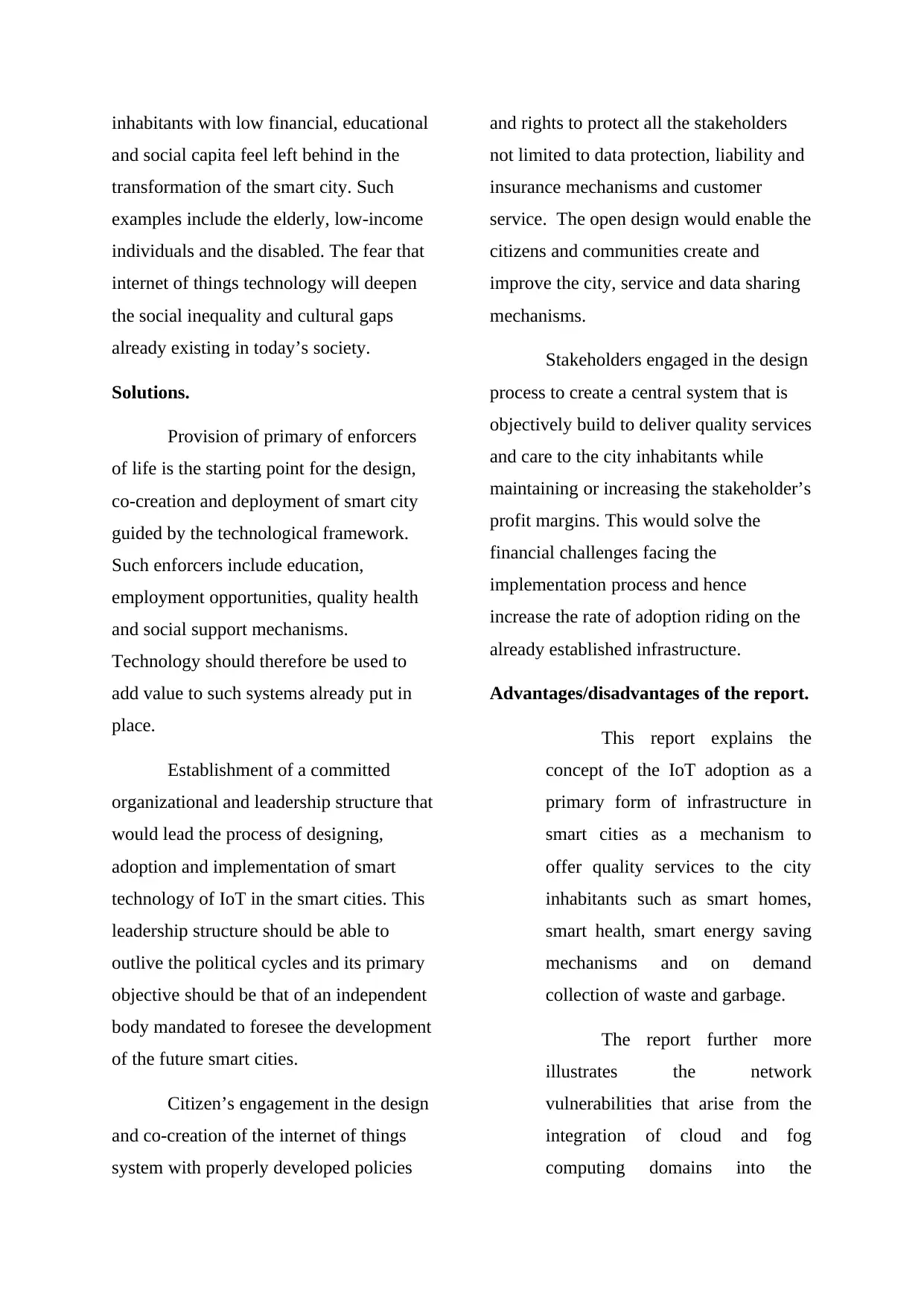
inhabitants with low financial, educational
and social capita feel left behind in the
transformation of the smart city. Such
examples include the elderly, low-income
individuals and the disabled. The fear that
internet of things technology will deepen
the social inequality and cultural gaps
already existing in today’s society.
Solutions.
Provision of primary of enforcers
of life is the starting point for the design,
co-creation and deployment of smart city
guided by the technological framework.
Such enforcers include education,
employment opportunities, quality health
and social support mechanisms.
Technology should therefore be used to
add value to such systems already put in
place.
Establishment of a committed
organizational and leadership structure that
would lead the process of designing,
adoption and implementation of smart
technology of IoT in the smart cities. This
leadership structure should be able to
outlive the political cycles and its primary
objective should be that of an independent
body mandated to foresee the development
of the future smart cities.
Citizen’s engagement in the design
and co-creation of the internet of things
system with properly developed policies
and rights to protect all the stakeholders
not limited to data protection, liability and
insurance mechanisms and customer
service. The open design would enable the
citizens and communities create and
improve the city, service and data sharing
mechanisms.
Stakeholders engaged in the design
process to create a central system that is
objectively build to deliver quality services
and care to the city inhabitants while
maintaining or increasing the stakeholder’s
profit margins. This would solve the
financial challenges facing the
implementation process and hence
increase the rate of adoption riding on the
already established infrastructure.
Advantages/disadvantages of the report.
This report explains the
concept of the IoT adoption as a
primary form of infrastructure in
smart cities as a mechanism to
offer quality services to the city
inhabitants such as smart homes,
smart health, smart energy saving
mechanisms and on demand
collection of waste and garbage.
The report further more
illustrates the network
vulnerabilities that arise from the
integration of cloud and fog
computing domains into the
and social capita feel left behind in the
transformation of the smart city. Such
examples include the elderly, low-income
individuals and the disabled. The fear that
internet of things technology will deepen
the social inequality and cultural gaps
already existing in today’s society.
Solutions.
Provision of primary of enforcers
of life is the starting point for the design,
co-creation and deployment of smart city
guided by the technological framework.
Such enforcers include education,
employment opportunities, quality health
and social support mechanisms.
Technology should therefore be used to
add value to such systems already put in
place.
Establishment of a committed
organizational and leadership structure that
would lead the process of designing,
adoption and implementation of smart
technology of IoT in the smart cities. This
leadership structure should be able to
outlive the political cycles and its primary
objective should be that of an independent
body mandated to foresee the development
of the future smart cities.
Citizen’s engagement in the design
and co-creation of the internet of things
system with properly developed policies
and rights to protect all the stakeholders
not limited to data protection, liability and
insurance mechanisms and customer
service. The open design would enable the
citizens and communities create and
improve the city, service and data sharing
mechanisms.
Stakeholders engaged in the design
process to create a central system that is
objectively build to deliver quality services
and care to the city inhabitants while
maintaining or increasing the stakeholder’s
profit margins. This would solve the
financial challenges facing the
implementation process and hence
increase the rate of adoption riding on the
already established infrastructure.
Advantages/disadvantages of the report.
This report explains the
concept of the IoT adoption as a
primary form of infrastructure in
smart cities as a mechanism to
offer quality services to the city
inhabitants such as smart homes,
smart health, smart energy saving
mechanisms and on demand
collection of waste and garbage.
The report further more
illustrates the network
vulnerabilities that arise from the
integration of cloud and fog
computing domains into the
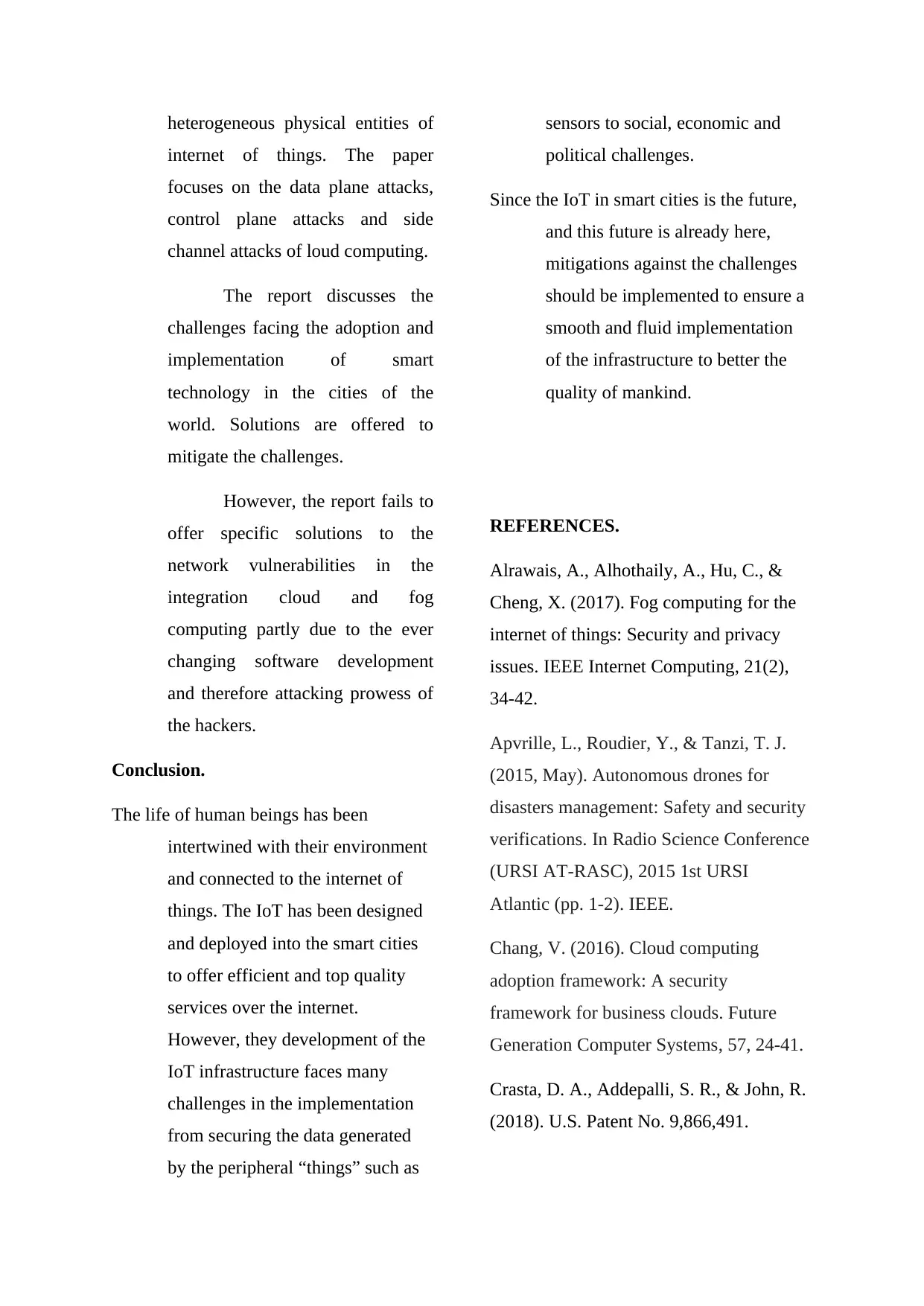
heterogeneous physical entities of
internet of things. The paper
focuses on the data plane attacks,
control plane attacks and side
channel attacks of loud computing.
The report discusses the
challenges facing the adoption and
implementation of smart
technology in the cities of the
world. Solutions are offered to
mitigate the challenges.
However, the report fails to
offer specific solutions to the
network vulnerabilities in the
integration cloud and fog
computing partly due to the ever
changing software development
and therefore attacking prowess of
the hackers.
Conclusion.
The life of human beings has been
intertwined with their environment
and connected to the internet of
things. The IoT has been designed
and deployed into the smart cities
to offer efficient and top quality
services over the internet.
However, they development of the
IoT infrastructure faces many
challenges in the implementation
from securing the data generated
by the peripheral “things” such as
sensors to social, economic and
political challenges.
Since the IoT in smart cities is the future,
and this future is already here,
mitigations against the challenges
should be implemented to ensure a
smooth and fluid implementation
of the infrastructure to better the
quality of mankind.
REFERENCES.
Alrawais, A., Alhothaily, A., Hu, C., &
Cheng, X. (2017). Fog computing for the
internet of things: Security and privacy
issues. IEEE Internet Computing, 21(2),
34-42.
Apvrille, L., Roudier, Y., & Tanzi, T. J.
(2015, May). Autonomous drones for
disasters management: Safety and security
verifications. In Radio Science Conference
(URSI AT-RASC), 2015 1st URSI
Atlantic (pp. 1-2). IEEE.
Chang, V. (2016). Cloud computing
adoption framework: A security
framework for business clouds. Future
Generation Computer Systems, 57, 24-41.
Crasta, D. A., Addepalli, S. R., & John, R.
(2018). U.S. Patent No. 9,866,491.
internet of things. The paper
focuses on the data plane attacks,
control plane attacks and side
channel attacks of loud computing.
The report discusses the
challenges facing the adoption and
implementation of smart
technology in the cities of the
world. Solutions are offered to
mitigate the challenges.
However, the report fails to
offer specific solutions to the
network vulnerabilities in the
integration cloud and fog
computing partly due to the ever
changing software development
and therefore attacking prowess of
the hackers.
Conclusion.
The life of human beings has been
intertwined with their environment
and connected to the internet of
things. The IoT has been designed
and deployed into the smart cities
to offer efficient and top quality
services over the internet.
However, they development of the
IoT infrastructure faces many
challenges in the implementation
from securing the data generated
by the peripheral “things” such as
sensors to social, economic and
political challenges.
Since the IoT in smart cities is the future,
and this future is already here,
mitigations against the challenges
should be implemented to ensure a
smooth and fluid implementation
of the infrastructure to better the
quality of mankind.
REFERENCES.
Alrawais, A., Alhothaily, A., Hu, C., &
Cheng, X. (2017). Fog computing for the
internet of things: Security and privacy
issues. IEEE Internet Computing, 21(2),
34-42.
Apvrille, L., Roudier, Y., & Tanzi, T. J.
(2015, May). Autonomous drones for
disasters management: Safety and security
verifications. In Radio Science Conference
(URSI AT-RASC), 2015 1st URSI
Atlantic (pp. 1-2). IEEE.
Chang, V. (2016). Cloud computing
adoption framework: A security
framework for business clouds. Future
Generation Computer Systems, 57, 24-41.
Crasta, D. A., Addepalli, S. R., & John, R.
(2018). U.S. Patent No. 9,866,491.
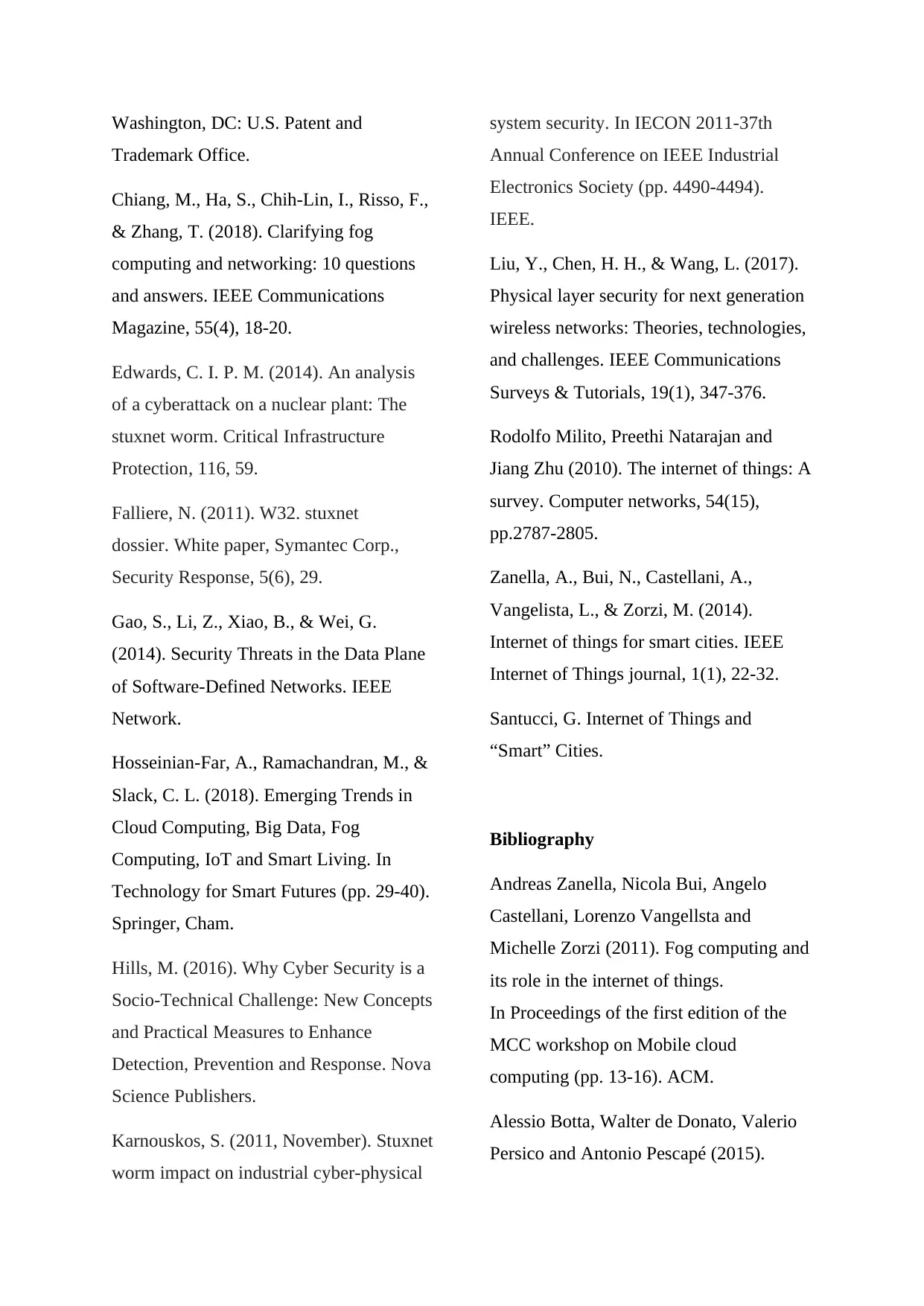
Washington, DC: U.S. Patent and
Trademark Office.
Chiang, M., Ha, S., Chih-Lin, I., Risso, F.,
& Zhang, T. (2018). Clarifying fog
computing and networking: 10 questions
and answers. IEEE Communications
Magazine, 55(4), 18-20.
Edwards, C. I. P. M. (2014). An analysis
of a cyberattack on a nuclear plant: The
stuxnet worm. Critical Infrastructure
Protection, 116, 59.
Falliere, N. (2011). W32. stuxnet
dossier. White paper, Symantec Corp.,
Security Response, 5(6), 29.
Gao, S., Li, Z., Xiao, B., & Wei, G.
(2014). Security Threats in the Data Plane
of Software-Defined Networks. IEEE
Network.
Hosseinian-Far, A., Ramachandran, M., &
Slack, C. L. (2018). Emerging Trends in
Cloud Computing, Big Data, Fog
Computing, IoT and Smart Living. In
Technology for Smart Futures (pp. 29-40).
Springer, Cham.
Hills, M. (2016). Why Cyber Security is a
Socio-Technical Challenge: New Concepts
and Practical Measures to Enhance
Detection, Prevention and Response. Nova
Science Publishers.
Karnouskos, S. (2011, November). Stuxnet
worm impact on industrial cyber-physical
system security. In IECON 2011-37th
Annual Conference on IEEE Industrial
Electronics Society (pp. 4490-4494).
IEEE.
Liu, Y., Chen, H. H., & Wang, L. (2017).
Physical layer security for next generation
wireless networks: Theories, technologies,
and challenges. IEEE Communications
Surveys & Tutorials, 19(1), 347-376.
Rodolfo Milito, Preethi Natarajan and
Jiang Zhu (2010). The internet of things: A
survey. Computer networks, 54(15),
pp.2787-2805.
Zanella, A., Bui, N., Castellani, A.,
Vangelista, L., & Zorzi, M. (2014).
Internet of things for smart cities. IEEE
Internet of Things journal, 1(1), 22-32.
Santucci, G. Internet of Things and
“Smart” Cities.
Bibliography
Andreas Zanella, Nicola Bui, Angelo
Castellani, Lorenzo Vangellsta and
Michelle Zorzi (2011). Fog computing and
its role in the internet of things.
In Proceedings of the first edition of the
MCC workshop on Mobile cloud
computing (pp. 13-16). ACM.
Alessio Botta, Walter de Donato, Valerio
Persico and Antonio Pescapé (2015).
Trademark Office.
Chiang, M., Ha, S., Chih-Lin, I., Risso, F.,
& Zhang, T. (2018). Clarifying fog
computing and networking: 10 questions
and answers. IEEE Communications
Magazine, 55(4), 18-20.
Edwards, C. I. P. M. (2014). An analysis
of a cyberattack on a nuclear plant: The
stuxnet worm. Critical Infrastructure
Protection, 116, 59.
Falliere, N. (2011). W32. stuxnet
dossier. White paper, Symantec Corp.,
Security Response, 5(6), 29.
Gao, S., Li, Z., Xiao, B., & Wei, G.
(2014). Security Threats in the Data Plane
of Software-Defined Networks. IEEE
Network.
Hosseinian-Far, A., Ramachandran, M., &
Slack, C. L. (2018). Emerging Trends in
Cloud Computing, Big Data, Fog
Computing, IoT and Smart Living. In
Technology for Smart Futures (pp. 29-40).
Springer, Cham.
Hills, M. (2016). Why Cyber Security is a
Socio-Technical Challenge: New Concepts
and Practical Measures to Enhance
Detection, Prevention and Response. Nova
Science Publishers.
Karnouskos, S. (2011, November). Stuxnet
worm impact on industrial cyber-physical
system security. In IECON 2011-37th
Annual Conference on IEEE Industrial
Electronics Society (pp. 4490-4494).
IEEE.
Liu, Y., Chen, H. H., & Wang, L. (2017).
Physical layer security for next generation
wireless networks: Theories, technologies,
and challenges. IEEE Communications
Surveys & Tutorials, 19(1), 347-376.
Rodolfo Milito, Preethi Natarajan and
Jiang Zhu (2010). The internet of things: A
survey. Computer networks, 54(15),
pp.2787-2805.
Zanella, A., Bui, N., Castellani, A.,
Vangelista, L., & Zorzi, M. (2014).
Internet of things for smart cities. IEEE
Internet of Things journal, 1(1), 22-32.
Santucci, G. Internet of Things and
“Smart” Cities.
Bibliography
Andreas Zanella, Nicola Bui, Angelo
Castellani, Lorenzo Vangellsta and
Michelle Zorzi (2011). Fog computing and
its role in the internet of things.
In Proceedings of the first edition of the
MCC workshop on Mobile cloud
computing (pp. 13-16). ACM.
Alessio Botta, Walter de Donato, Valerio
Persico and Antonio Pescapé (2015).
Secure Best Marks with AI Grader
Need help grading? Try our AI Grader for instant feedback on your assignments.
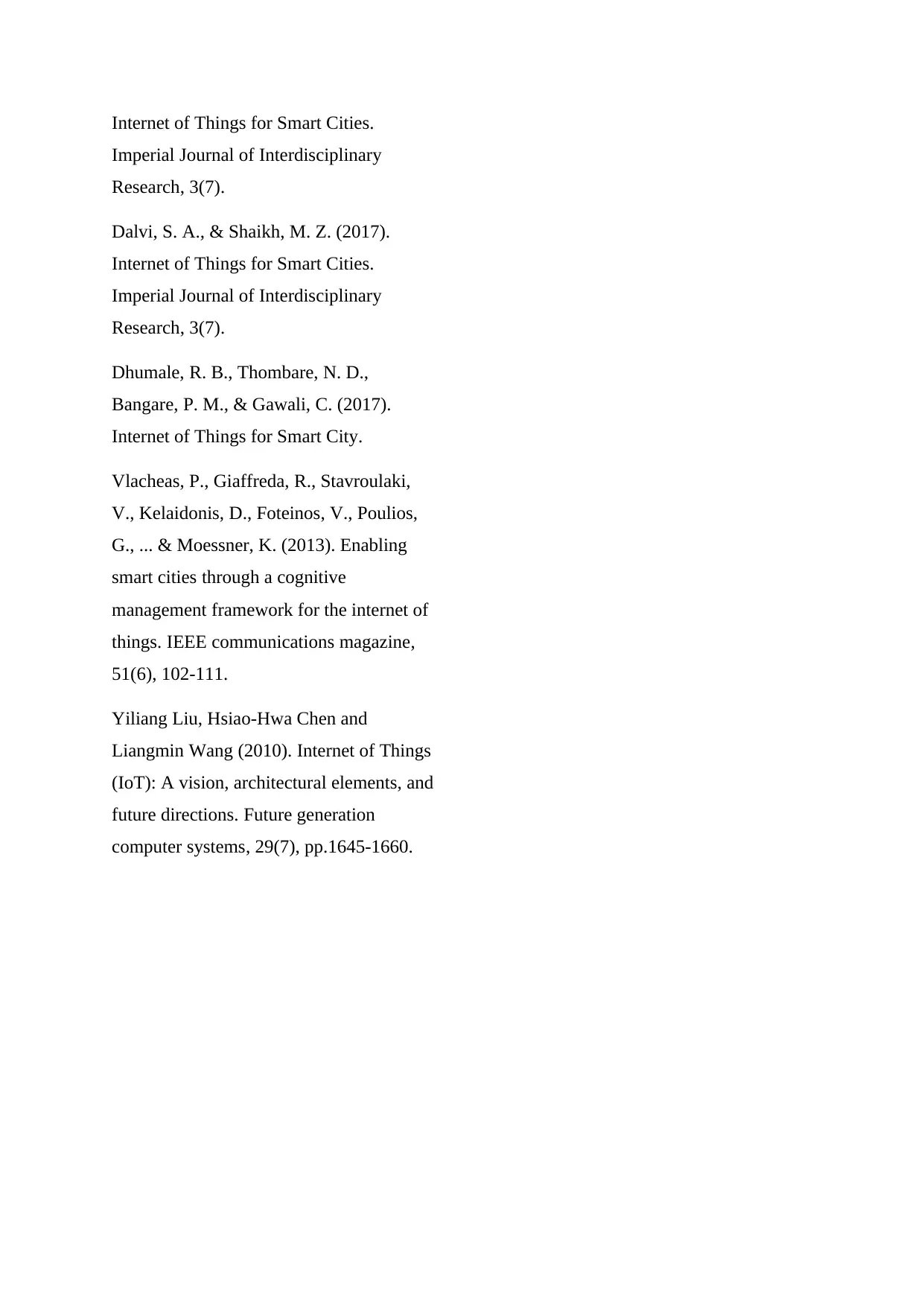
Internet of Things for Smart Cities.
Imperial Journal of Interdisciplinary
Research, 3(7).
Dalvi, S. A., & Shaikh, M. Z. (2017).
Internet of Things for Smart Cities.
Imperial Journal of Interdisciplinary
Research, 3(7).
Dhumale, R. B., Thombare, N. D.,
Bangare, P. M., & Gawali, C. (2017).
Internet of Things for Smart City.
Vlacheas, P., Giaffreda, R., Stavroulaki,
V., Kelaidonis, D., Foteinos, V., Poulios,
G., ... & Moessner, K. (2013). Enabling
smart cities through a cognitive
management framework for the internet of
things. IEEE communications magazine,
51(6), 102-111.
Yiliang Liu, Hsiao-Hwa Chen and
Liangmin Wang (2010). Internet of Things
(IoT): A vision, architectural elements, and
future directions. Future generation
computer systems, 29(7), pp.1645-1660.
Imperial Journal of Interdisciplinary
Research, 3(7).
Dalvi, S. A., & Shaikh, M. Z. (2017).
Internet of Things for Smart Cities.
Imperial Journal of Interdisciplinary
Research, 3(7).
Dhumale, R. B., Thombare, N. D.,
Bangare, P. M., & Gawali, C. (2017).
Internet of Things for Smart City.
Vlacheas, P., Giaffreda, R., Stavroulaki,
V., Kelaidonis, D., Foteinos, V., Poulios,
G., ... & Moessner, K. (2013). Enabling
smart cities through a cognitive
management framework for the internet of
things. IEEE communications magazine,
51(6), 102-111.
Yiliang Liu, Hsiao-Hwa Chen and
Liangmin Wang (2010). Internet of Things
(IoT): A vision, architectural elements, and
future directions. Future generation
computer systems, 29(7), pp.1645-1660.
1 out of 17
Related Documents
Your All-in-One AI-Powered Toolkit for Academic Success.
+13062052269
info@desklib.com
Available 24*7 on WhatsApp / Email
![[object Object]](/_next/static/media/star-bottom.7253800d.svg)
Unlock your academic potential
© 2024 | Zucol Services PVT LTD | All rights reserved.




